Hanwha Techwin DIGIMAXV6 Digital Camera User Manual
Samsung Techwin Co Ltd Digital Camera Users Manual
Contents
- 1. User Manual 1
- 2. User Manual 2
User Manual 2
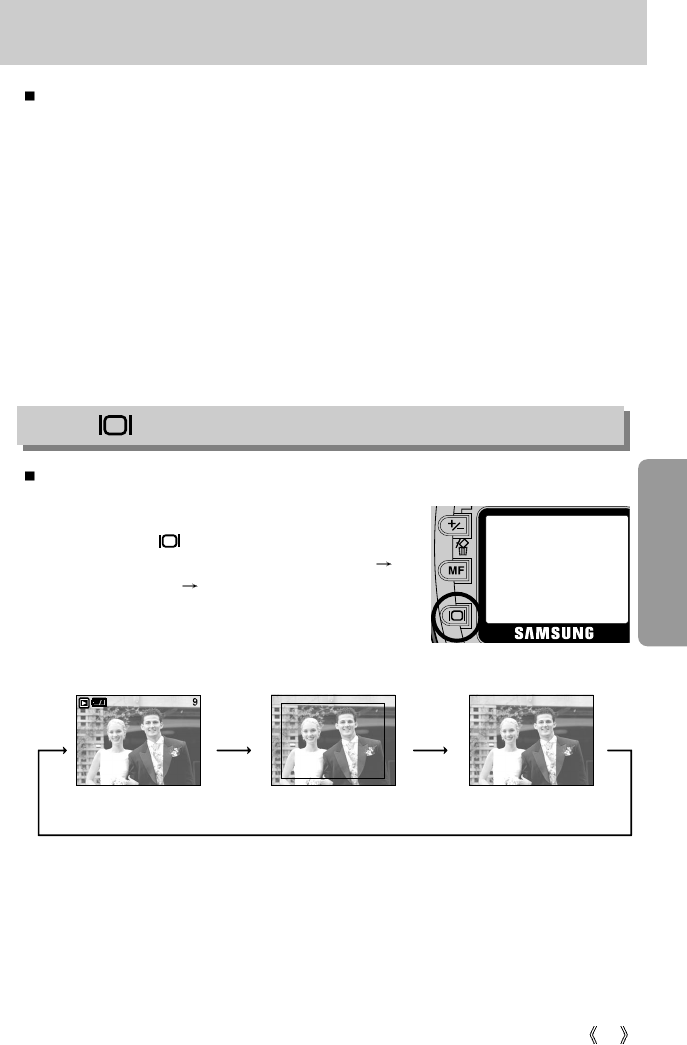
61
DOWN/ LEFT/ RIGHT/ MENU/ OK button
DOWN/ LEFT/ RIGHT/ MENU/ OK buttons activate the following.
- DOWN button : While the menu is showing, press the DOWN button to move from the
main menu to a sub menu, or to move down the sub menu cursor.
- LEFT button : While the menu is showing, press the LEFT button to select the menu
tab to the left of the cursor.
- RIGHT button : While the menu is showing, press the RIGHT button to select the menu
tab to the right of the cursor, or to move an secondary menu.
- MENU button : When you press the MENU button, the play mode menu will be
displayed on the LCD monitor. Pressing it again will return the LCD to
the initial display.
- OK button : When the menu is displayed on the LCD monitor, the OK button is used
for confirming data that is changed by using the 5 function button.
The shooting information will be displayed on the LCD monitor.
The last image stored in the memory is displayed on the
LCD monitor by pressing the play mode button.
Pressing the LCD( ) button in the PLAY mode will
change the display as shown below. [Image & Icons]
[Image & Information] [Image only]
[ Image & Icons ] [ Image & Information ] [ Image only ]
Pressing the LCD button
Pressing the
LCD button
Pressing the
LCD button
LCD( ) button
SIZE : 2816X2112
AV : F2.7
TV : 1/30
ISO : 50
FLASH : OFF
DATE : 2004/07/01
* The LCD button is not available for voice recording in play mode.
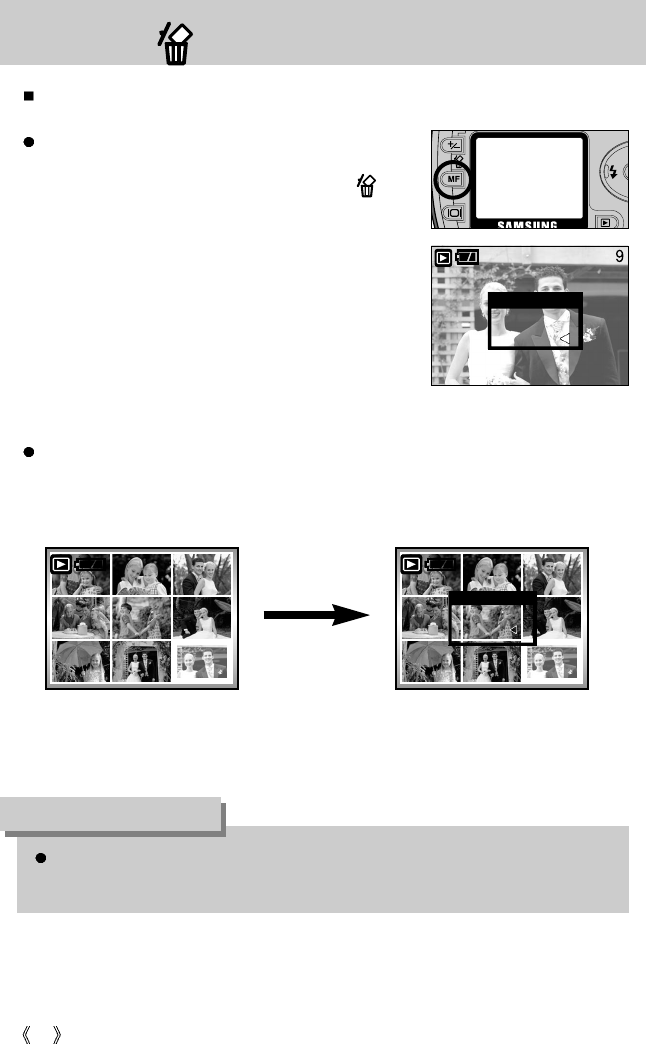
62
Delete ( ) button
This deletes images stored on the memory card.
Before deleting images from the camera, you should protect (p.67) or download images
(p.106) to your computer that you wish to keep.
INFORMATION
Deleting Images in Play Mode
1. Select an image that you want to delete by pressing the
LEFT / RIGHT button and press the DELETE ( )
button.
2. A message will display as shown alongside on the LCD
monitor.
3. Press the OK button to delete the image.
DELETE ?
DEL:OK
CANCEL:
Deleting Images in Thumbnail Display Mode
1. Use the Up/Down/Left/Right buttons to select an image to delete.
2. Press the Delete button to display the following message in the LCD monitor.
Press the DELETE
button.
1 2 3
4 5 6
7 8 9
1 2 3
4 5 6
7 8 9
DELETE ?
DEL:OK
CANCEL:
3. Press the OK button to delete the image.
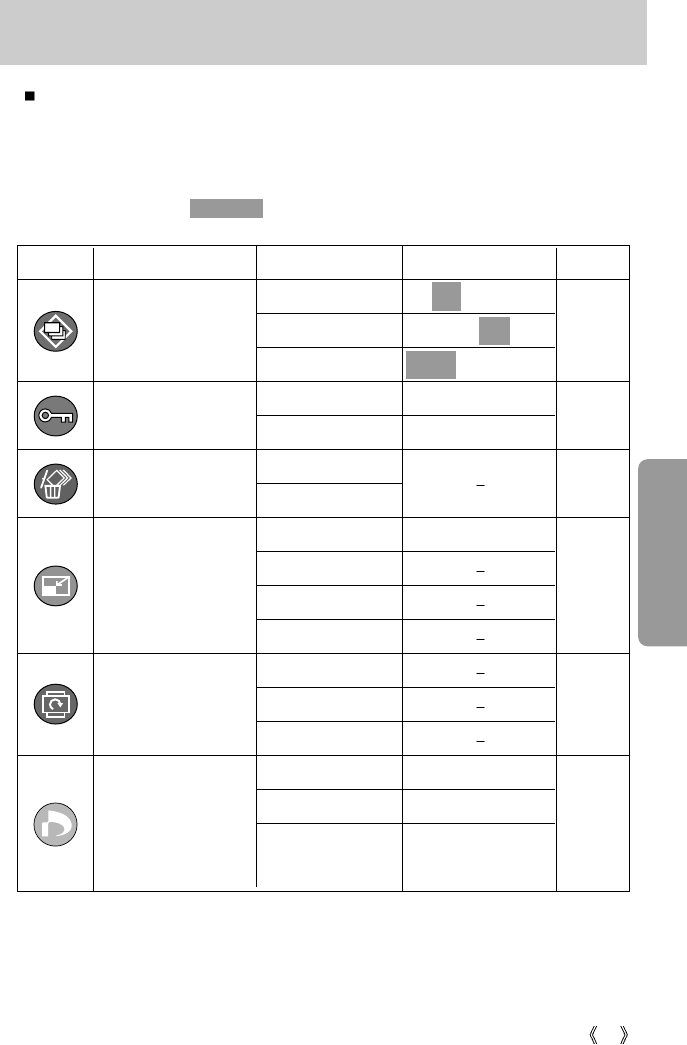
63
Setting up the play back function using the LCD monitor
PLAY mode functions can be changed by using the LCD monitor. In the PLAY mode,
pressing the MENU button displays the menu on the LCD monitor. The menus you can set
up in Play mode are as follows. To capture an image after setting up the play menu, press
the PLAY button.
The items indicated by are default settings.
Menu tab Main menu Sub menu Secondary menu Page
PROTECT
DELETE
RESIZE
ROTATE
SLIDE
DPOF
p. 69
p. 67
p. 68
p. 70
p. 67
p. 70
~ p. 72
SELECT
ALL PICS
SELECT
ALL PICS
OFF / 1~10SEC
ON / OFF
CANCEL / EFFECT1, 2, 3, 4
UNLOCK / LOCK
UNLOCK / LOCK
1600X1200
1280X960
800X600
LOGO
RIGHT
LEFT
UPDOWN
INTERVAL
REPEAT
EFFECT
SIZE
STANDARD
INDEX
SELECT/ ALL PICS/ CANCEL
NO/ YES
SELECT/ ALL PICS/
CANCEL
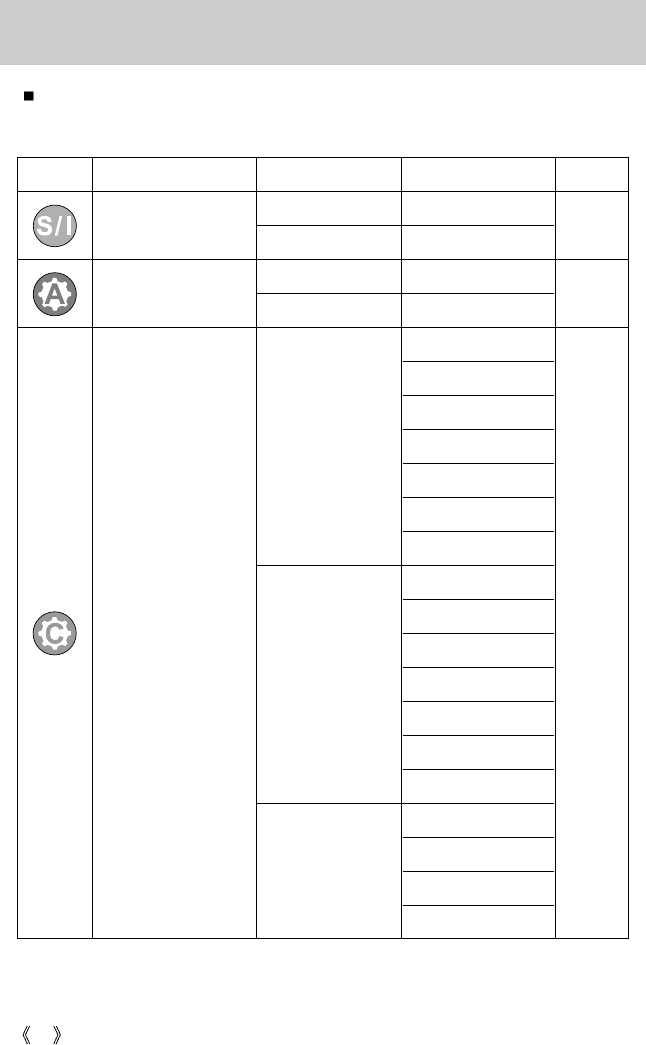
64
Setting up the play back function using the LCD monitor
Menu tab Main menu Sub menu Secondary menu Page
-
-
-
-
AUTO
POSTCARD
4X6
8X10
A6
A4
B5
AUTO
FULL
1
2
4
6
8
AUTO
PLAIN
PHOTO
FASTPHO.
AUTO SET
CUSTOM SET
IMAGES
p. 75
p. 75
p. 74
YES
NO
SIZE
LAYOUT
TYPE
ONE PIC
ALL PICS
This menu is available while the camera is connected to a PictBridge supporting printer
(direct connection to the camera, sold separately) with a USB cable.
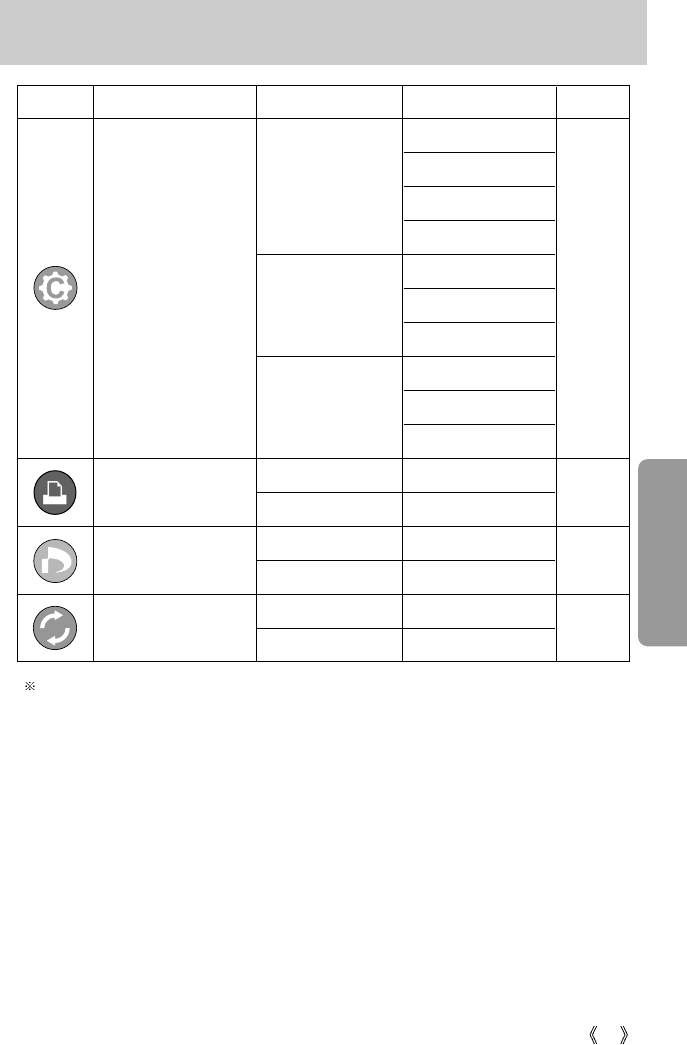
65
Setting up the play back function using the LCD monitor
QUALITY
Menu tab Main menu Sub menu Secondary menu Page
AUTO
DRAFT
NORMAL
FINE
AUTO
OFF
ON
AUTO
OFF
ON
STANDARD -
INDEX -
YES -
NO -
YES -
NO -
PRINT
CUSTOM SET
p. 76
p. 76
p. 77
p. 75
FILE NAME
DATE
DPOF PRINT
RESET
Menus are subject to change without prior notice.
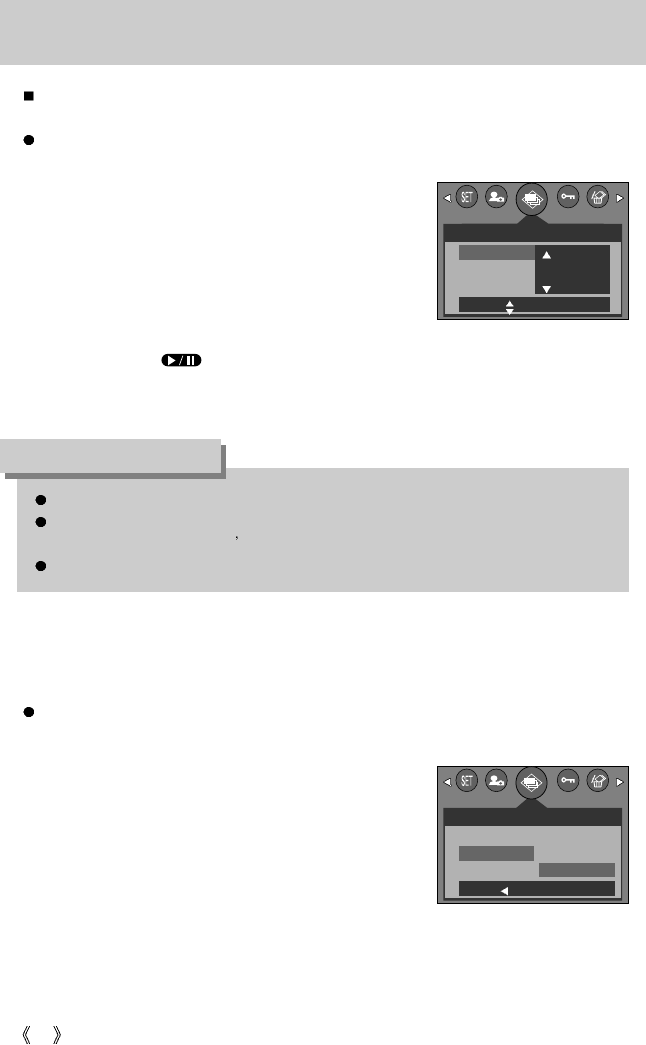
66
Starting the slide show
Images can be displayed continuously at pre-set intervals.
You can view the slide show by connecting the camera to an external monitor.
Configure the interval for the slide show
: Configure the length of time to display each picture in the slide show.
1. Press the play mode button and press the menu button.
2. Press the LEFT/ RIGHT button and select the [SLIDE]
menu tab.
3. Select the [INTERVAL] sub menu by pressing the UP/
DOWN button and press the RIGHT button.
4. Use the Up/Down Button to establish the display interval.
- Slide Show Display Interval : OFF, 1 ~10 seconds
5. Use the Right Button to start the slide show.
Use the Pause ( ) Button to pause and resume the slide show.
To cancel the slide show in the middle of the show, press the Pause button and the LEFT
or RIGHT button.
The loading time depends on the image size and quality.
The slide show will start from an image that was displayed on the LCD monitor.
The [PWR OFF] function can t be activated.
While the slide show is playing, only the first frame of an MOVIE file is displayed.
INFORMATION
Configure slide show repeat mode
: Automatically restart the slide show after displaying all pictures.
Steps 1 and 2 are the same as for the [INTERVAL] section.
3. Select the [REPEAT] sub menu by pressing the UP/
DOWN button and press the RIGHT button.
4. Use the Up/Down Button to select the repeat mode.
[ON] : The slide show will repeat until turned off.
[OFF]: The slide show will not repeat after the first
showing.
5. Press the OK button to confirm the setting.
6. Press the OK button again and the slide show will start.
SLIDE
INTERVAL
REPEAT
EFFECT
MOVE: SET:OK
OFF
SLIDE
INTERVAL
REPEAT
EFFECT
BACK: SET:OK
ON
OFF
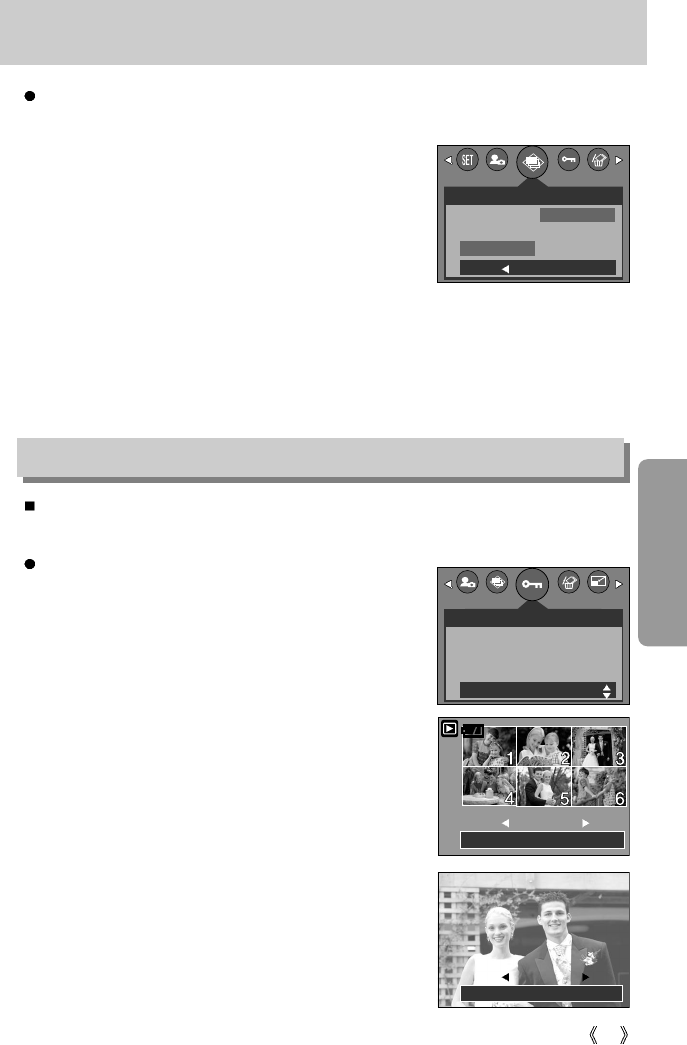
67
Starting the slide show
Protecting images
Configure slide show effects: Unique screen effects can be used for the slide show.
Steps 1 and 2 are the same as for the [INTERVAL] section.
3. Select the [EFFECT] sub menu by pressing the UP/
DOWN button and press the RIGHT button.
4. Use the Up/Down Button to select the type of effect.
[CANCEL] : Normal display.
[EFFECT 1] : Image is displayed slowly.
[EFFECT 2] : Image is displayed slowly from the
center outwards.
[EFFECT 3] : Image moves from the top left.
[EFFECT 4] : The image slides diagonally from top left to bottom right.
5. Press the OK button to confirm the setting.
6. Press the OK button again and the slide show will start.
This is used to protect specific shots from being accidentally erased (LOCK).
It also unprotects images that have been previously protected (UNLOCK).
Protecting Images
1. Press the play mode button and press the menu button.
2. Press the LEFT/ RIGHT button and select the
[PROTECT] menu tab.
3. Select a desired sub menu by pressing the UP/ DOWN
button and press the OK button.
[SELECT] : Selection window for an image to be
protected/released is displayed.
- Up/Down/Left/Right : Select an image
- Zoom W/T Button : Protect/release the image
- Menu Button : Your changes will be saved and the
menu will disappear.
[ALL PICS] : Protect/release all saved images
- Zoom W/T Button : Protect/release the images
- Menu Button : Your changes will be saved and the
menu will disappear.
SLIDE
INTERVAL
REPEAT
EFFECT
BACK: SET:OK
CANCEL
EFFECT1
EFFECT2
PROTECT
SELECT
ALL PICS
EXIT:MENU MOVE:
SET:OK
WUNLOCK T
SET:OK
WUNLOCK T
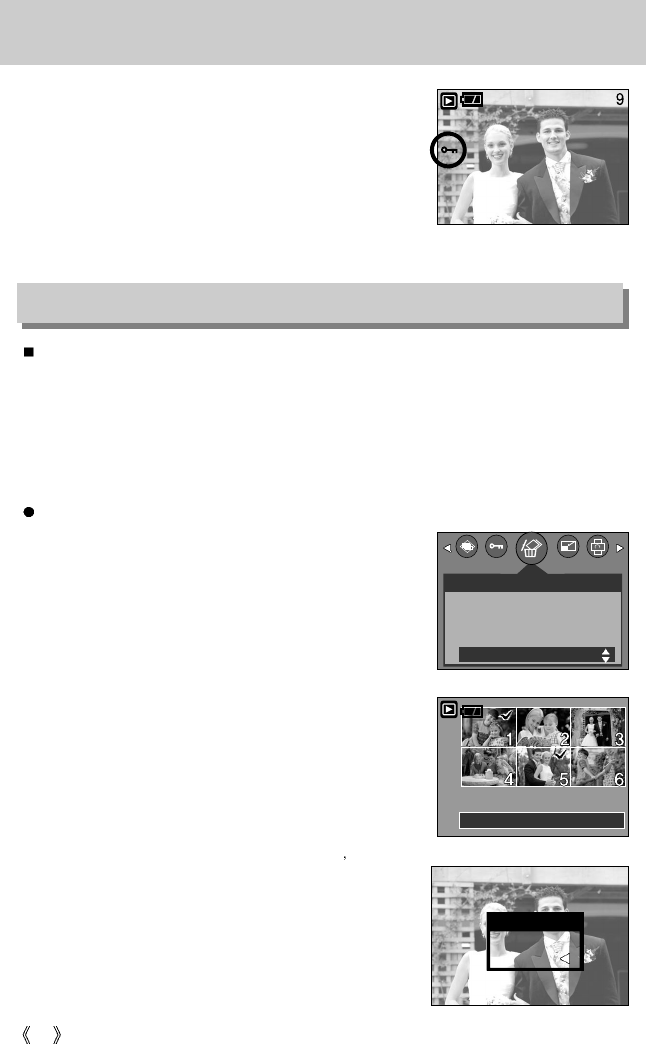
68
Protecting images
- If you protect an image, the protect icon will be displayed
on the LCD monitor. (An unprotected image has no
indicator)
- An image in LOCK mode will be protected from the
delete function or [DELETE] functions, but will NOT be
protected from the [FORMAT] function.
Deleting images
Of all the files stored in the memory card, the unprotected files in the DCIM subfolder will be
deleted. Remember that this will permanently delete unprotected images.
Important shots should be stored on a computer before deletion takes place. The startup
image is stored in the camera's internal memory (i.e., not on the memory card) and it will not
be deleted even if you delete all files on the memory card.
Deleting images
1. Press the play mode button and press the menu button.
2. Press the LEFT/ RIGHT button and select the [DELETE]
menu tab.
3. Select a desired sub menu by pressing the UP/ DOWN
button and press the OK button.
[SELECT]: Selection window for an image to delete is
displayed.
- Up/Down/Left/Right: Select an image
- Zoom T Button: Select the image for deletion.
(V mark)
- OK Button: Press the OK Button to display confirmation
message
Press the OK Button again to delete V marked images.
[ALL PICS]: Displays confirmation window
Press the OK Button again to delete all
unprotected images. If there aren t protected
images, all the images are deleted and a [NO
IMAGE!] message will display.
4. After deletion, the screen will be changed to the play
mode screen.
DELETE
SELECT
ALL PICS
EXIT:MENU MOVE:
DEL:OK
SELECT :T
DELETE ?
DEL:OK
CANCEL:
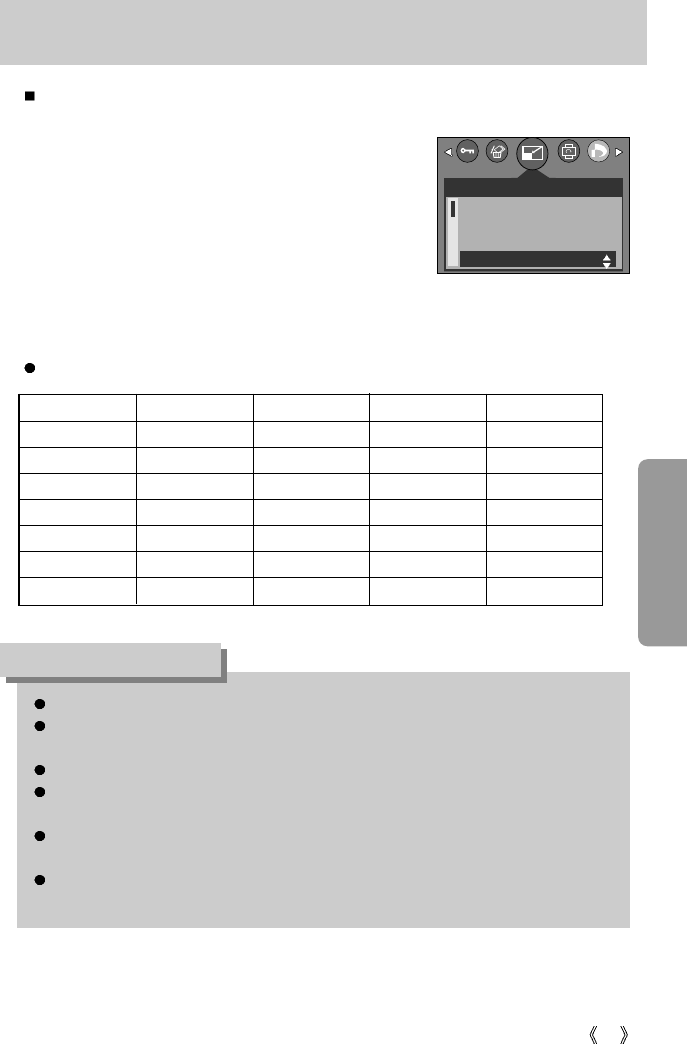
69
Resize
Change the resolution (size) of pictures taken. Select [LOGO] to save an image to be the
start-up image. The resized image will have a new file name.
1. Press the play mode button and press the menu button.
2. Press the LEFT/ RIGHT button and select the [RESIZE]
menu tab.
3. Select a desired sub menu by pressing the UP/ DOWN
button and press the OK button.
[RESIZE] sub menu : 1600X1200, 1280X960, 800X600,
LOGO
A large sized image can be resized to a smaller sized image, but not vice versa.
Only still image(JPEG) images can be resized. TIFF, Movie clip(AVI) and Voice
recording(WAV) files can’t be resized.
You can change the resolution of only those files compressed in the JPEG 4:2:2 format.
The resized image will have a new file name. The [LOGO] image is stored not on the
memory card but on the internal memory.
Only one [LOGO] image can be saved. If you save a new [LOGO] image, the existing
startup image will be deleted.
If the memory capacity is insufficient to store the resized image, a [CARD FULL!]
message will display on the LCD monitor and the resized image will not be stored.
INFORMATION
Image Resize Types
RESIZE
1600X1200
1280X960
800X600
EXIT:MENU MOVE:
Size 1600X1200 1280X960 800X600 LOGO
2816 O O O O
2560 O O O O
2272 O O O O
2048 O O O O
1600 O O O O
1024 X X O O
640 X X X O
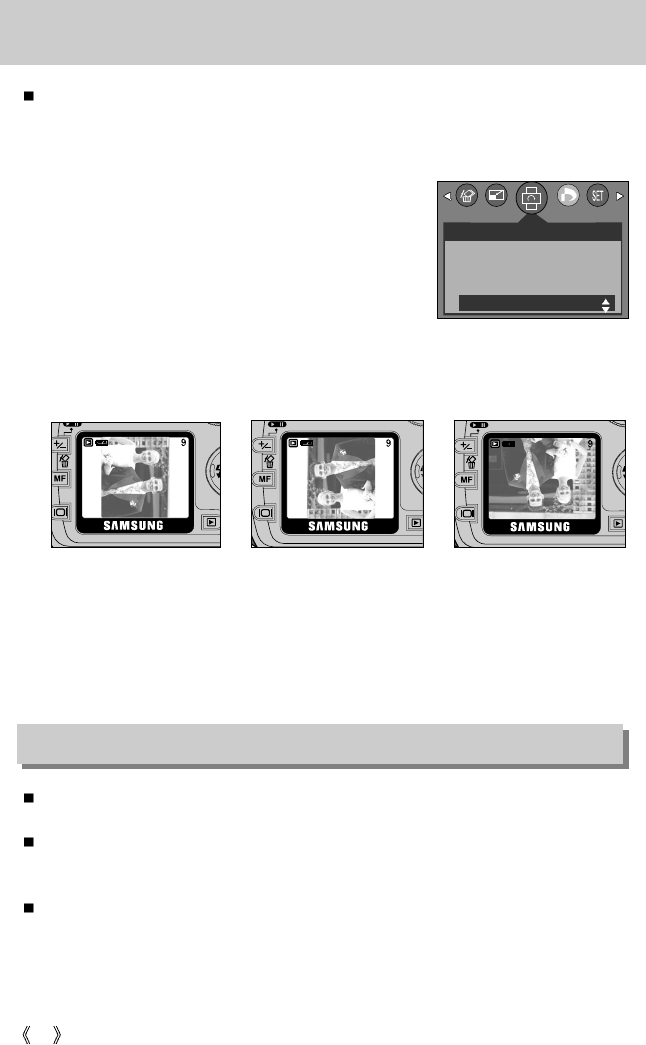
70
Rotating an image
DPOF
DPOF(Digital Print Order Format) allows you to embed printing information on your memory
card’s MISC folder. Select the pictures to be printed and how many prints to make.
The DPOF indicator will display on the LCD monitor when an image that has DPOF
information plays back. Images can then be printed on DPOF printers, or at an increasing
number of photo labs.
This function is not available for Movie clips and Voice recording files.
You can rotate the stored images by 90, 180, or 270 degrees.
You can view a picture in its proper orientation if the picture has been taken with the camera
oriented vertically or up-side-down. Once the playback of the rotated picture is finished, it will
switch back to the original state.
1. Press the play mode button and press the menu button.
2. Press the LEFT/ RIGHT button and select the [ROTATE]
menu tab.
3. Select a desired sub menu by pressing the UP/ DOWN
button.
[RIGHT] : Rotate picture in a clock-wise direction
[LEFT] : Rotate picture in a counter-clock-wise
direction
[UPDOWN] : Rotate picture 180 degrees
[ Picture after 90 degrees ]
CCW rotation
[ Picture after 180 degrees ]
rotation
[ Picture after 90 degrees ]
CW rotation
4. Press the OK button. The rotated image will be displayed and the menu will disappear.
If you display the rotated image on the LCD monitor, empty spaces may appear to the left
and right of the image.
ROTATE
RIGHT
LEFT
UPDOWN
EXIT:MENU MOVE:
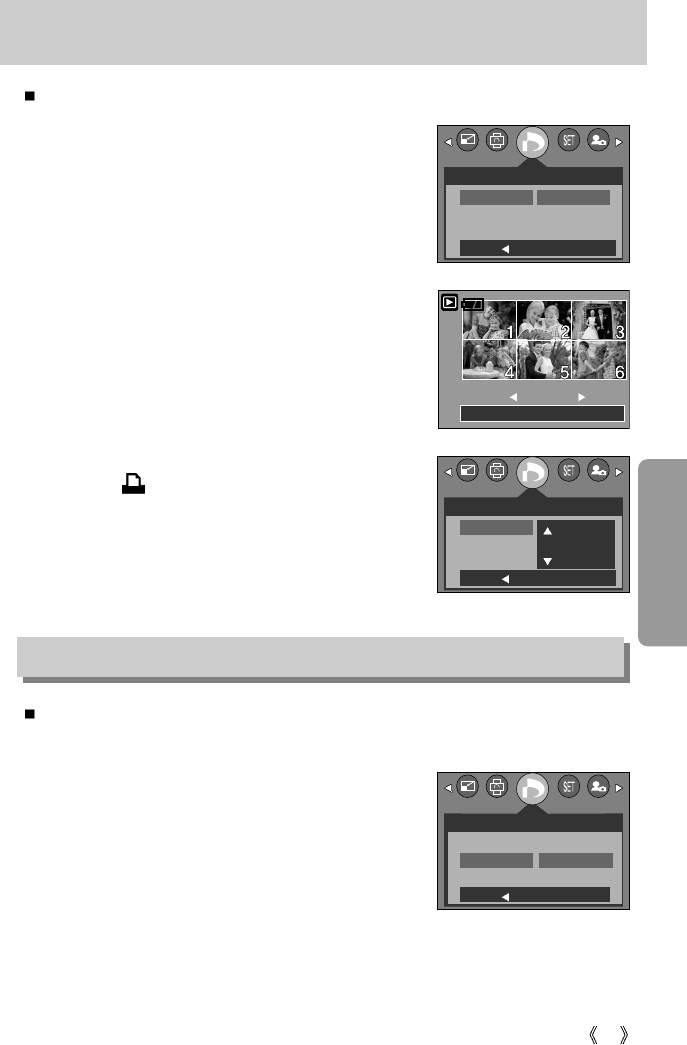
71
DPOF : STANDARD
Images (except for movie clips and voice file) are printed as index type.
1. Press the play mode button and press the menu button.
2. Press the LEFT/ RIGHT button and select the [DPOF]
menu tab.
3. Select the [INDEX] menu by pressing the UP/ DOWN
button and press the RIGHT button.
4. Select a desired sub menu by pressing the UP/ DOWN
button.
If [NO] is selected : Cancel the index print setting.
If [YES] is selected : The image will be printed in index
format.
5. Press the OK button to confirm the setting.
DPOF : INDEX
This function allows you to embed print quantity information on a stored image.
1. Press the play mode button and press the menu button.
2. Press the LEFT/ RIGHT button and select the [DPOF]
menu tab.
3. Select the [STANDARD] menu by pressing the UP/
DOWN button and press the RIGHT button.
4. Select a desired sub menu by pressing the UP/ DOWN
button and press the OK button.
[SELECT]: Selection window for an image to print is
displayed.
- Up/Down/Left/Right: Select an image to print.
- Zoom W/T Button: Select the number of prints.
[ALL PICS] : Configure number of prints for all pictures
except movie and voice files.
[CANCEL] : Cancel the print setup.
5. Press the OK button to confirm the setting.
If an image carries DPOF instructions, the DPOF
indicator ( ) will show.
DPOF
BACK: SET:OK
SET:OK
W 0 PRINTS T
DPOF
STANDARD
INDEX
SIZE
BACK: SET:OK
NO
YES
STANDARD
INDEX
SIZE
SELECT
ALL PICS
CANCEL
DPOF
BACK: SET:OK
STANDARD
INDEX
SIZE
0 PRINTS
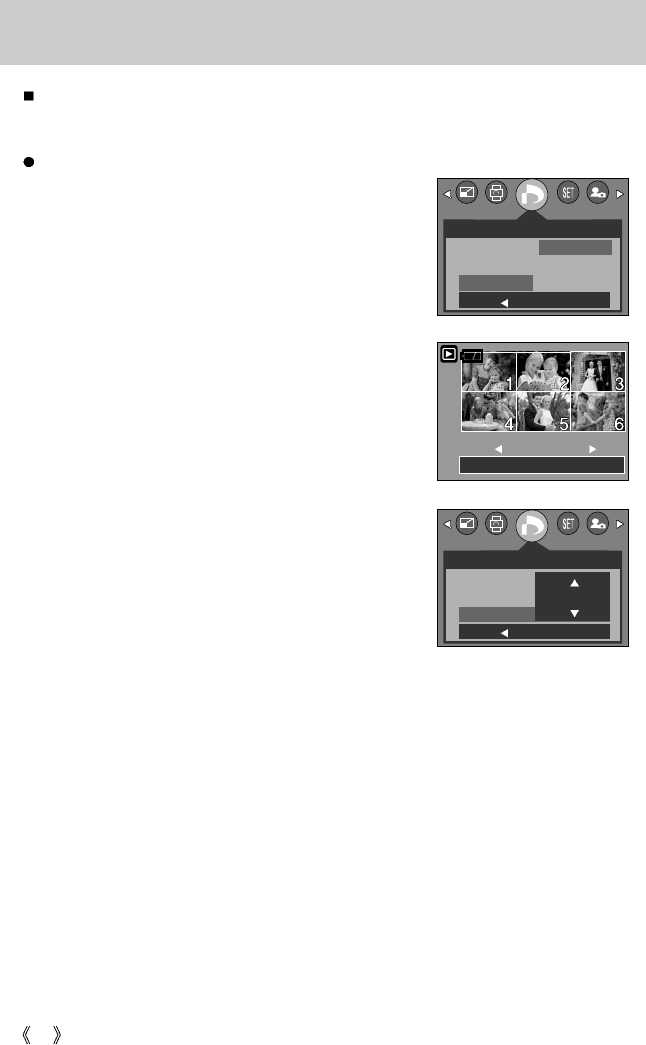
72
DPOF : PRINT SIZE
You can specify the print size when printing images stored on the memory card.
The [SIZE] menu is available only for DPOF 1.1 compatible printers.
Setting the Print Size
1. Press the play mode button and press the menu button.
2. Press the LEFT/ RIGHT button and select the [DPOF]
menu tab.
3. Select the [SIZE] menu by pressing the UP/ DOWN
button and press the RIGHT button.
4. Select a desired sub menu by pressing the UP/ DOWN
button and press the OK button.
[SELECT] : Selection window for an image to be changed
printed size is displayed.
- Up/Down/Left/Right : Select an image.
- Zoom W/T Button : Change the print size.
- OK button : Your changes will be saved and the menu
will disappear.
[ALL PICS] : Change print size of all saved images.
- Up/Down/Left/Right : Select an image.
- OK button : Confirm the changed setting.
[CANCEL] : Cancel all of the print size settings.
* DPOF [SIZE] secondary menu : CANCEL, 3X5, 4X6, 5X7,
8X10
DPOF
STANDARD
INDEX
SIZE
BACK: SET:OK
SELECT
ALL PICS
CANCEL
SET:OK
WCANCEL T
DPOF
STANDARD
INDEX
SIZE
BACK: SET:OK
CANCEL
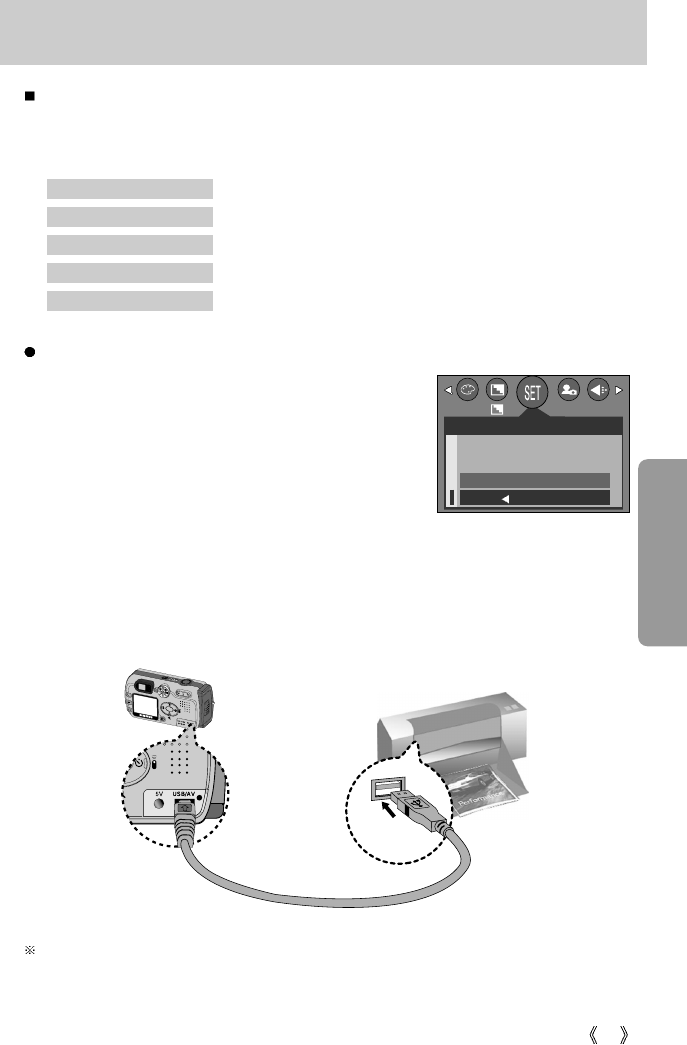
73
PictBridge
If you selected [COMPUTER] in Step 5, when you connect the camera to your printer, the
Mode dial lamp(Green) will illuminate and the connection will not be established. In this case,
disconnect the USB cable, and then follow the procedure from Step 2 and onward.
SETUP
Q. VIEW
RESET
USB
BACK: SET:OK
COMPUTER
PRINTER
NOR 2816
Connecting the Camera to a Printer
1. Slide the power switch to turn the camera power on.
2. In a mode other than Voice Recording mode, press the
MENU button.
3. Press the LEFT/ RIGHT button and select [SETUP]
menu tab.
4. Select [USB] menu by pressing the UP/ DOWN button
and press the RIGHT button.
5. Select [PRINTER] menu by pressing the UP/ DOWN
button and press the OK button.
6. Press the menu button twice and the menu will disappear.
7. Use the supplied USB cable to connect the camera to the printer as shown below.
8. Turn on the printer to connect the camera to the printer.
You can use the USB cable to connect this camera to a printer that supports PictBridge (sold
separately) and print the stored images directly. TIFF, Movie clips and voice files cannot be
printed. You can set up the following settings from the PictBridge menu.
IMAGES : Select the pictures to be printed.
PRINTER SETUP : Setting up printing(AUTO SET/CUSTOM SET)
PRINT : Printing pictures
DPOF AUTO PRINT : Printing the DPOF files
RESET : Initializing the PictBridge functions
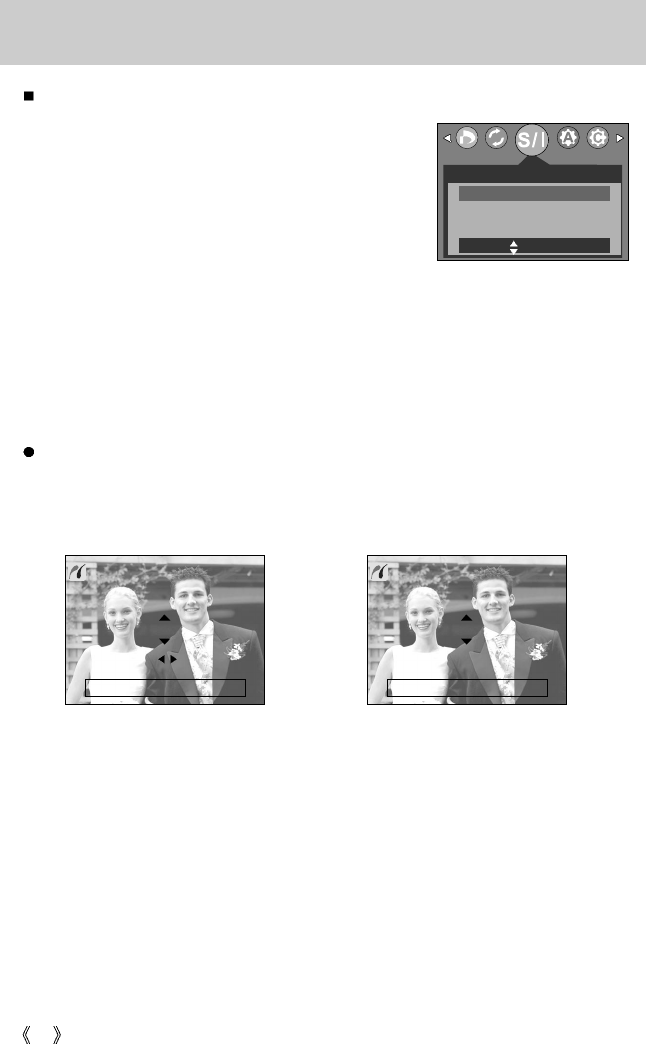
74
PictBridge: Picture Selection
Select pictures to print
1. Connect the camera to your printer. The USB menu must
be set to [PRINTER] before you connect the camera to
the printer.(See p.86)
2. The [IMAGES] menu will appear.
3. Use the UP and DOWN buttons to select the desired
submenu value, and then press the OK button.
When [ONE PIC] is selected : The PictBridge function will
be applied only to the picture currently displayed.
When [ALL PICS] is selected : The PictBridge function will be applied to all pictures,
excluding TIFF, movie clips and voice files.
[ When [ONE PIC] is selected ] [ When [ALL PICS] is selected ]
- Press the Up/Down button to select the number of prints. Maximum 30 prints.
- Use the Left/Right button to select another picture and select the number of prints for
another picture.
- After setting the number of prints, press the OK button to save.
- Press the Shutter button to return to the menu without setting the number of prints.
0
EXIT:SHUTTER SET:OK
IMAGES
ONE PIC
ALL PICS
MOVE: SET:OK
Setting the Number of Copies to Print
- Select [ONE PIC] or [ALL PICS]. A screen where you can set the number of copies to print
will appear as shown below.
PREV NEXT
0
EXIT:SHUTTER SET:OK
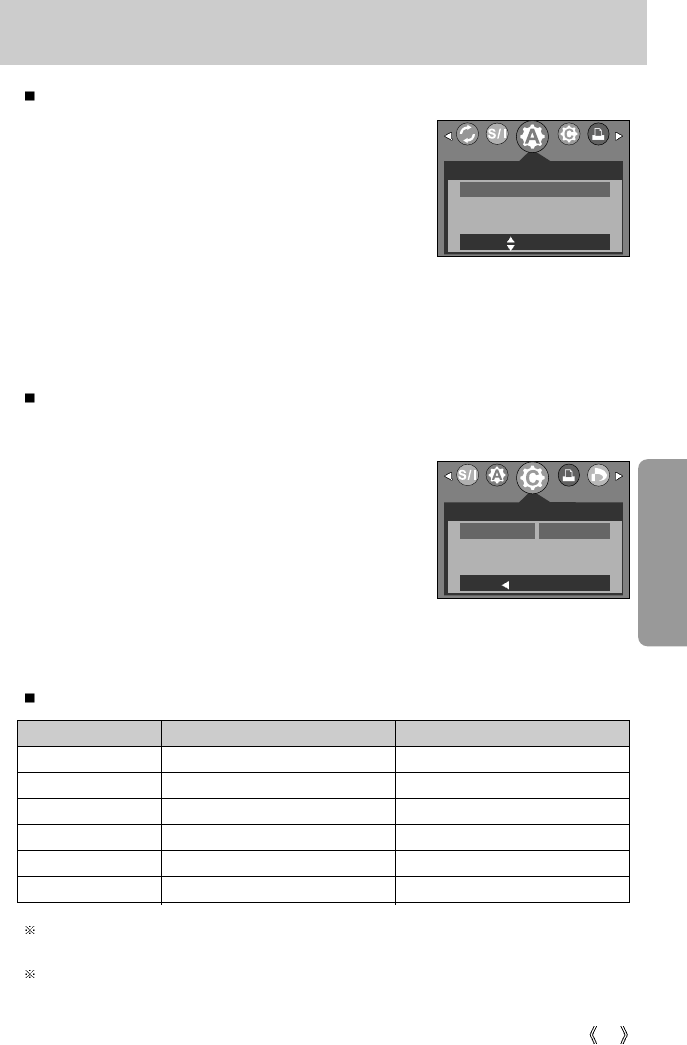
75
PictBridge: Print Setting
Menu
SIZE Setting the size of the printing paper
AUTO, POSTCARD, 4x6, 8x10, A6, A4, B5
LAYOUT
Setting the number of pictures to be printed on a sheet of paper
AUTO, FULL, 1, 2, 4, 6, 8
TYPE Setting the quality of the printing paper AUTO, PLAIN, PHOTO, FASTPHO.
QUALITY
Setting the quality of the picture to be printed
AUTO, DRAFT, NORMAL, FINE
DATE Setting whether to print the date AUTO, OFF, ON
FILE NAME Setting whether to print the file name AUTO, OFF, ON
AUTO SET
1. Connect the camera to your printer. The USB menu
must be set to [PRINTER] before you connect the
camera to the printer.(See p.86)
2. Use the LEFT and RIGHT buttons to select the [AUTO
SET] menu tab.
3. Use the UP and DOWN buttons to select the desired
submenu value, and then press the OK button.
[YES]: All values in the [CUSTOM SET] are
automatically changed.
[NO] : [CUSTOM SET] values are kept.
Some menu options are not supported in all manufacturer and printer models. If not
supported, the menus are still displayed in the LCD, but are not selectable.
If the setting values are not changed in the automatic/manual setting, the setting values are
automatically kept.
AUTO SET
YES
NO
MOVE: SET:OK
CUSTOM SET
SIZE
LAYOUT
TYPE
AUTO
POST DARD
4X6
BACK: SET:OK
1. Connect the camera to your printer. The [USB] menu
must be set to [PRINTER] before you connect the
camera to the printer.(See p.86)
2. Use the LEFT and RIGHT buttons to select the
[CUSTOM SET] menu tab.
3. Use the UP and DOWN buttons to select the desired
submenu value, and then press the RIGHT button.
4. Use the UP and DOWN buttons to select the desired
submenu value, and then press the OK button.
CUSTOM SET : You can select the Paper Size, Print Format, Paper Type, Print Quality, Date
Print, and File Name Print menus for printed pictures.
Function Sub menu
The menus you can set up are as follows:
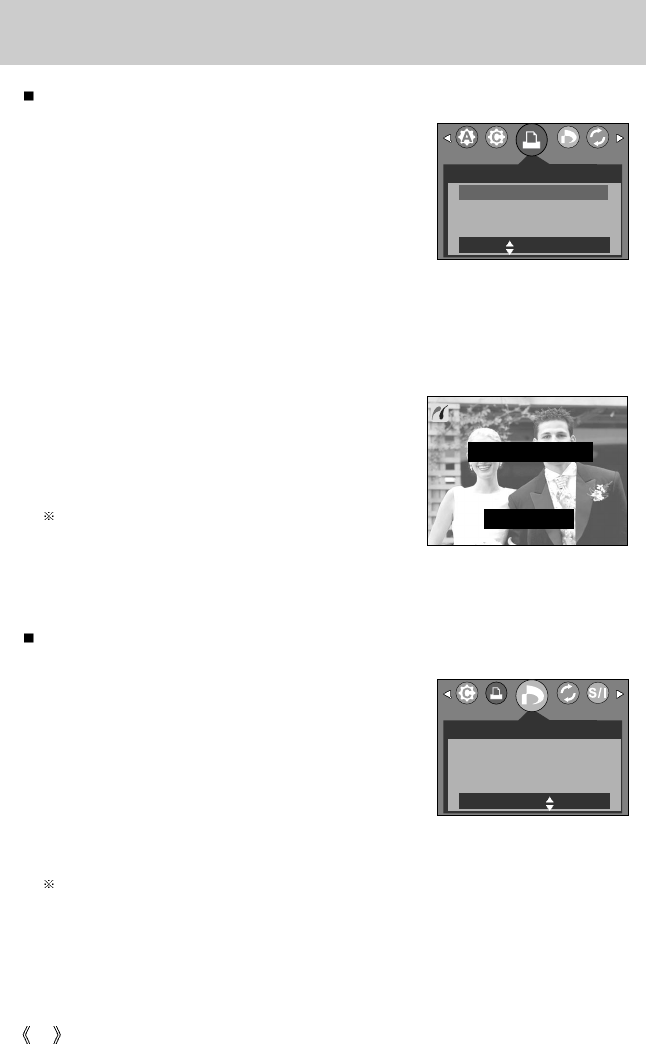
76
PictBridge: Printing
Printing Pictures
1. Connect the camera to your printer. The USB menu
must be set to [PRINTER] before you connect the
camera to the printer.(See p.86)
2. Use the LEFT and RIGHT buttons to select the [PRINT]
menu tab.
3. Use the UP and DOWN buttons to select the desired
submenu value, and then press the OK button.
[STANDARD] :
Print the pictures stored in the memory
card in set numbers. One picture is printed on one piece of paper.
[INDEX] : Print multiple images on one sheet of paper.
PRINT
STANDARD
INDEX
MOVE: SET:OK
DPOF PRINT
YES
NO
MOVE:
1. Connect the camera to your printer. The [USB] menu
must be set to [PRINTER] before you connect the
camera to the printer.(See p.86)
2. Use the LEFT and RIGHT buttons to select the [ DPOF
PRINT] menu tab.
3. Use the UP and DOWN buttons to select the desired
submenu value, and then press the OK button.
[YES]: Directly print the file with the DPOF information
[NO] : Cancel the printing
Depending on the manufacturer and printer model, some menus may not be available.
With a printer without supporting the DPOF, the menu is still displayed but not available.
NOW PRINTING
CANCEL:OK
1/1
4. The screen shown on the right will appear and the
picture will be printed. If no picture is selected, the [NO
IMAGE!] message will be displayed. Press the
Menu/OK button while printing to cancel the printing and
the [IMAGES] menu is displayed.
Number of pictures in a index print varies depends on
the printer used.
DPOF PRINT : This allows you to directly print the files with DPOF information.
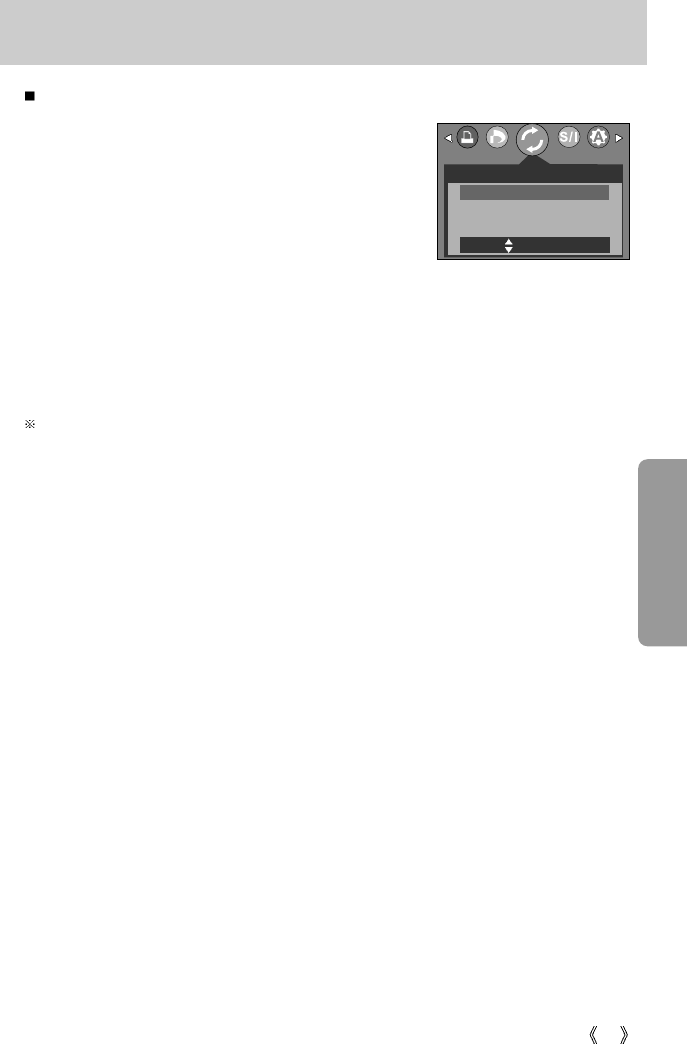
77
PictBridge : RESET
Initializes user-changed configurations.
1. Connect the camera to your printer. The [USB] menu
must be set to [PRINTER] before you connect the
camera to the printer.(See p.86)
2. Use the LEFT and RIGHT buttons to select the [RESET]
menu tab.
3. Use the UP and DOWN buttons to select the desired
submenu value, and then press the OK button.
- If [YES] is selected : All print and image settings will be
reset.
- If [NO] is selected : Settings will not be reset.
Default print setting varies depending on the printer manufacturer.
For your printer’s default setting, refer to the user’s guide that came with your printer.
RESET
YES
NO
MOVE: SET:OK
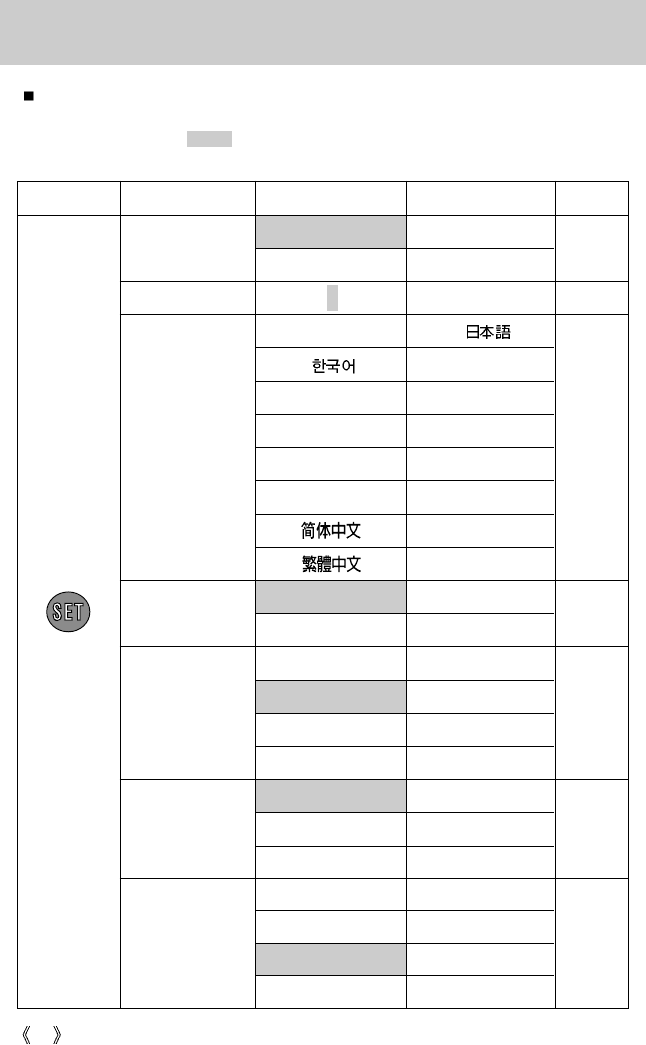
78
Setup menu
In this mode, you can set up basic settings. You can use the setup menu in all camera
modes, except Voice Recording mode.
The items indicated by are default settings.
Menu tab Main menu Sub menu Secondary menu Page
RESET
SERIES
OFF, 1~3~10MIN p.80
ENGLISH
P”CCK»…
FRANÇAIS PORTU.
DEUTSCH DUTCH
ESPAÑOL DANSK
ITALIANO SVENSKA
SUOMI
THAI
NO
YES
YY/MM/DD
DD/MM/YY
MM/DD/YY
OFF
DATE
D & TIME
OFF
LOW
MEDIUM
HIGH
04/07/01 13:00
FILE
PWR OFF
LANGUAGE
FORMAT
D & TIME
IMPRINT
SOUND
p.79
p.81
p.81
p.82
p.82
p.83
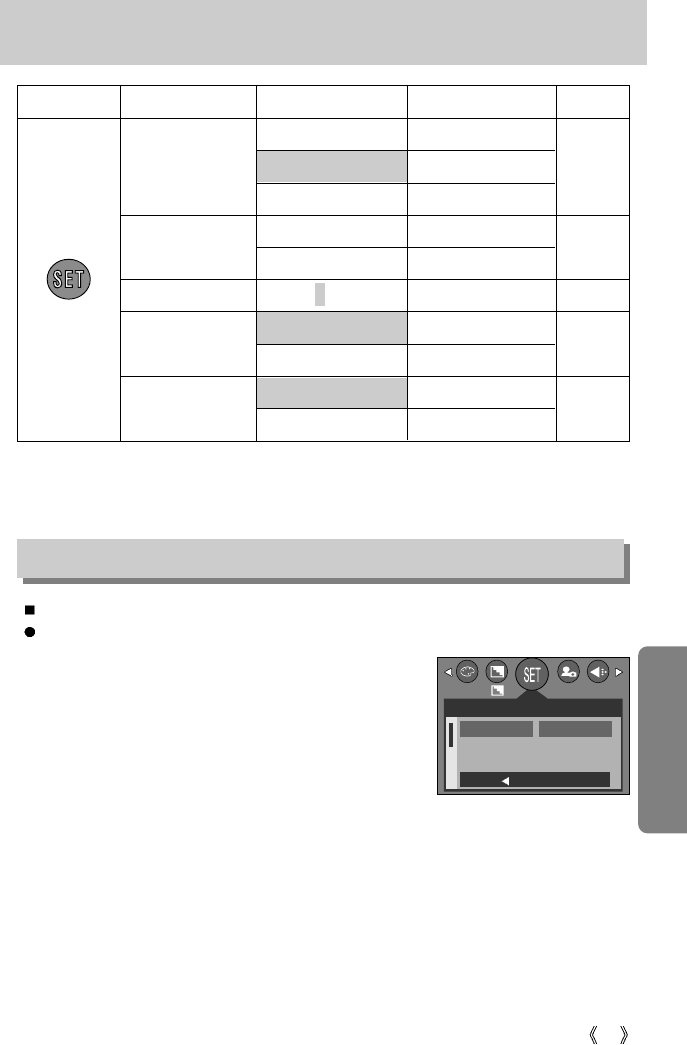
79
Setup menu
Menu tab Main menu Sub menu Secondary menu Page
DARK
NORMAL
BRIGHT
NTSC
PAL
NO
YES
COMPUTER
PRINTER
LCD
VIDEO
Q. VIEW
USB
RESET
This function allows the user to select the file naming format.
Assigning File Names
1. In any mode with the exception of Voice Recording mode,
press the MENU button.
2. Press the LEFT/ RIGHT button and select the [SETUP]
menu tab.
3. Select the [FILE] menu by pressing the UP/ DOWN button
and press the RIGHT button.
4. Select a desired sub menu by pressing the UP/ DOWN
button and press the OK button.
[RESET] : After using the reset function, the next file name
will be set from 0001 even after formatting, deleting all or inserting a new
memory card.
[SERIES]: New files are named using numbers that follow the previous sequence, even
when a new memory card is used, or after formatting, or after deleting all
pictures
5. Press the menu button twice and the menu will disappear.
File name
OFF, 1, 2, 3SEC
p.83
p.84
p.85
p.85
p.86
* Menus are subject to change without prior notice.
SETUP
FILE
PWR OFF
LANGUAGE
BACK: SET:OK
RESET
SERIES
NOR 2816
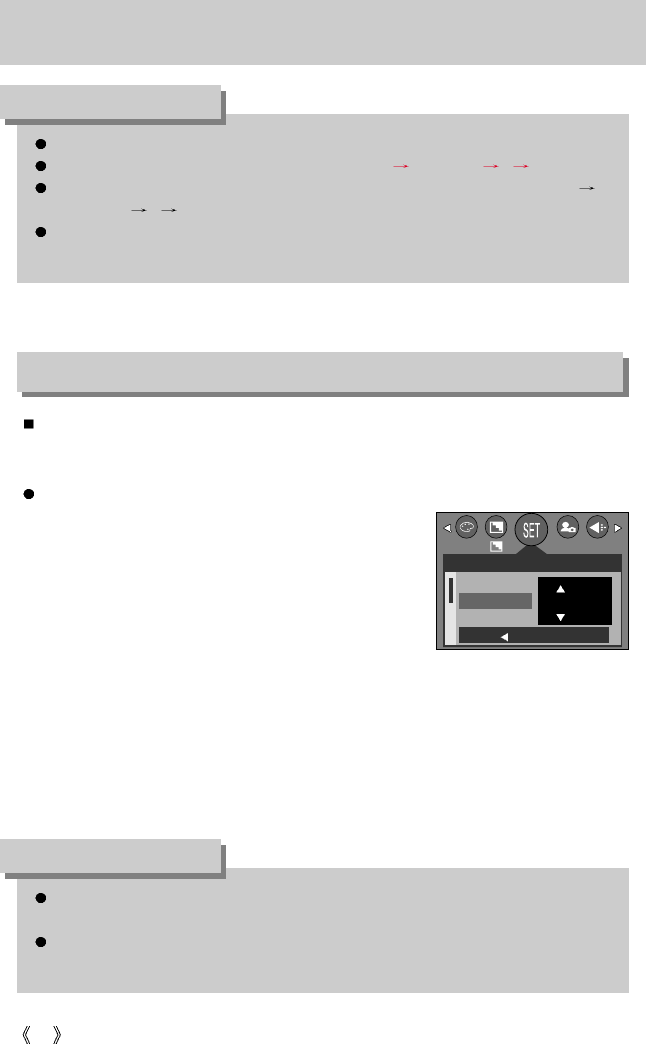
80
File name
The first stored folder name is 100SSCAM, and the first file name is SV600001.
File names are assigned sequentially from SV600001 SV600002 ~ SV609999.
The folder number is assigned sequentially from 100 to 999 as follows: 100SSCAM
101SSCAM ~ 999SSCAM.
The files used with the memory card conform to the DCF(Design rule for Camera File
systems) format.
INFORMATION
Even if the batteries or AC adapter are removed and inserted again, the power off setting
will be preserved.
Note that the automatic power off function will not operate if the camera is in PC mode,
slide show, playing back a voice recording or movie clip.
INFORMATION
Auto power off
Setting Power Off
1. In any mode with the exception of Voice Recording mode,
press the MENU button.
2. Press the LEFT/ RIGHT button and select the [SETUP]
menu tab.
3. Select the [PWR OFF] menu by pressing the UP/ DOWN
button and press the RIGHT button.
4. Select a desired sub menu by pressing the UP/ DOWN
button and press the OK button.
Selecting [OFF] : The power off function will not operate.
[1~10 MIN] : The power will turn off automatically if not used for the period of time
specified.
5. Press the menu button twice and the menu will disappear.
This function switches the camera off after a set amount of time in order to prevent
unnecessary battery drainage.
SETUP
FILE
PWR OFF
LANGUAGE
BACK: SET:OK
OFF
NOR 2816
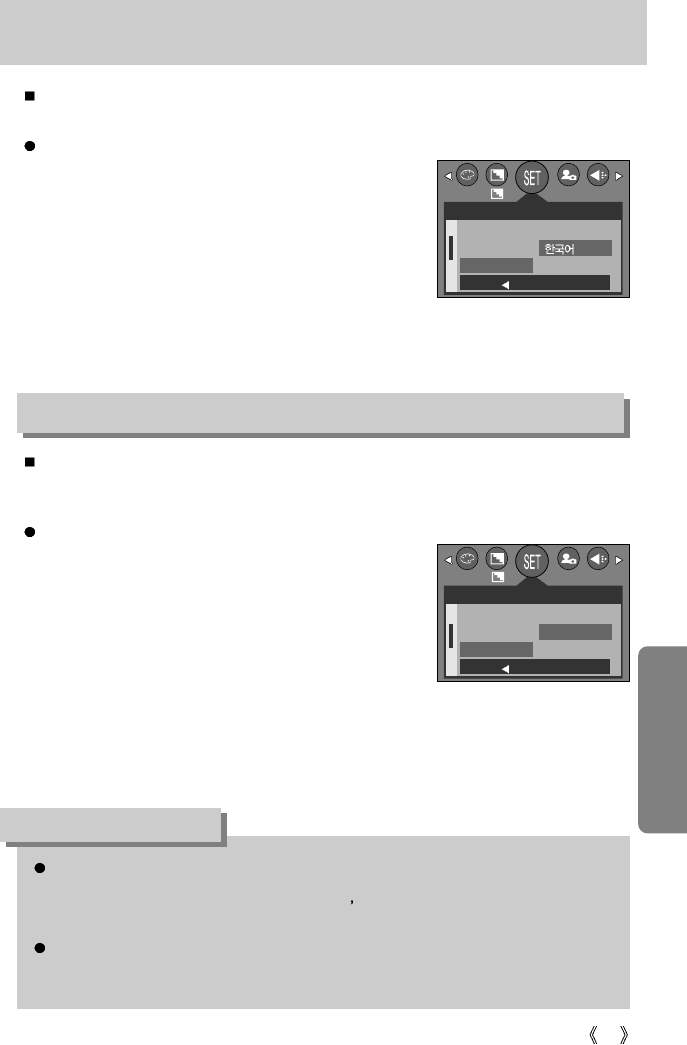
81
Language
Setting Language
1. In any mode with the exception of Voice Recording mode,
press the MENU button.
2. Press the LEFT/ RIGHT button and select the [SETUP]
menu tab.
3. Select the [LANGUAGE] menu by pressing the UP/
DOWN button and press the RIGHT button.
4. Select a desired sub menu by pressing the UP/ DOWN
button and press the OK button.
LANGUAGE sub menu : Korean, English, French, German, Spanish, Italian, T.Chinese,
S.Chinese, Japanese, Russian, Portuguese, Dutch, Danish, Swedish, Finnish, Thai.
5. Press the menu button twice and the menu will disappear.
Formatting a Memory Card
1. In any mode other than Voice Recording mode, press the
MENU button.
2. Press the LEFT/ RIGHT button and select the [SETUP]
menu tab.
3. Select the [FORMAT] menu by pressing the UP/ DOWN
button and press the RIGHT button.
4. Select a desired sub menu by pressing the UP/ DOWN
button and press the OK button.
If [NO] is selected : The memory card will not be formatted.
Press the menu button twice and the menu display will disappear.
If [YES] is selected : A [PLEASE WAIT!] message appears and the memory card will be
formatted. If you ran FORMAT in Play mode, a [NO IMAGE!]
message will appear.
There is a choice of languages that can be displayed on the LCD monitor. Even if the batteries or
AC adapter are removed and inserted again, the language setting will be preserved.
Formatting a memory card
This is used for formatting the memory card. If you run [FORMAT] on the memory card, all
images, including the protected images, will be deleted. Be sure to download important
images to your PC before formatting the memory card.
Be sure to run [FORMAT] on the following types of memory card.
- A new memory card, or an unformatted memory card.
- A memory card that has a file this camera can t recognize or one that has been taken
from another camera.
Always format the memory card using this camera. If you insert a memory card that has
been formatted using other cameras, memory card readers, or PCs, you will get a [CARD
ERROR!] message.
INFORMATION
SETUP
FILE
PWR OFF
LANGUAGE
BACK: SET:OK
ENGLISH
FRANÇAIS
SETUP
PWR OFF
LANGUAGE
FORMAT
BACK: SET:OK
NO
YES
NOR 2816
NOR 2816
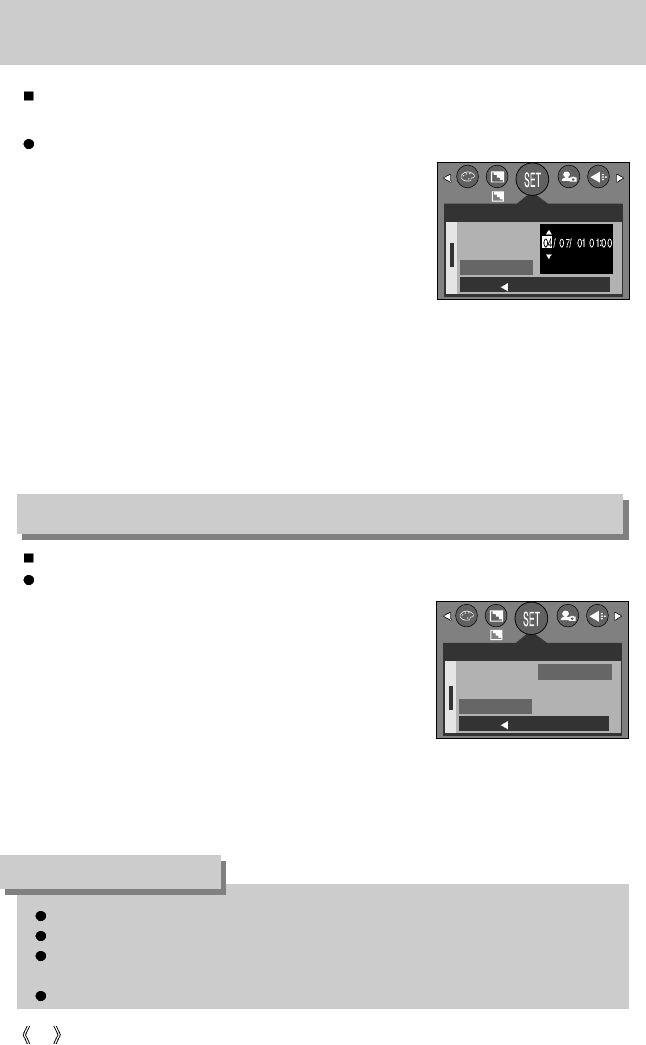
82
Setting up the Date/ Time/ Date type
You can change the date and time that will be displayed on the captured images and set up
the date type.
Setting Date/Time & Selecting Date Format
1. In any mode with the exception of Voice Recording mode,
press the MENU button.
2. Press the LEFT/ RIGHT button and select the [SETUP]
menu tab.
3. Select the [D&TIME] menu by pressing the UP/ DOWN
button and press the RIGHT button.
4. Use the UP, DOWN, LEFT, and RIGHT buttons to select
the desired submenu value, and then press the OK button.
RIGHT button : Selects the year/month / day/hour / minute date type.
LEFT button : Moves the cursor to the [D&TIME] main menu if the cursor is at the first
item of the date and time setup. In all other cases, the cursor will be
shifted to the left of its current position.
UP and DOWN buttons : Changes the setting value.
- Date type : [YY/MM/DD] /[DD/MM/YY] /[MM/DD/YY]
5. Press the menu button twice and the menu will disappear.
There is an option to include DATE/TIME on still images.
Date Imprinting
1. In any mode with the exception of Voice Recording mode,
press the MENU button.
2. Press the LEFT/ RIGHT button and select the [SETUP]
menu tab.
3. Select the [IMPRINT] menu by pressing the UP/ DOWN
button and press the RIGHT button.
4. Use the UP and DOWN buttons to select the desired date
imprint type, and then press the OK button.
[OFF]: The DATE & TIME will not be imprinted on the image file.
[DATE] : Only the DATE will be imprinted on the image file.
[D&TIME] : The DATE & TIME will be imprinted on the image file.
5. Press the menu button twice and the menu will disappear.
Imprinting the recording date
The Date & Time are imprinted at the bottom right side of the still image.
The date will be imprinted as a DATE TYPE setting.
TIME is imprinted in the following way : [Hour : Minute] and hours are shown using the 24
hour clock.
The imprint function is applied only to still images.
INFORMATION
SETUP
LANGUAGE
FORMAT
D & TIME
BACK: SET:OK
YY/MM/DD
SETUP
FORMAT
D & TIME
IMPRINT
BACK: SET:OK
OFF
DATE
D & TIME
NOR 2816
NOR 2816
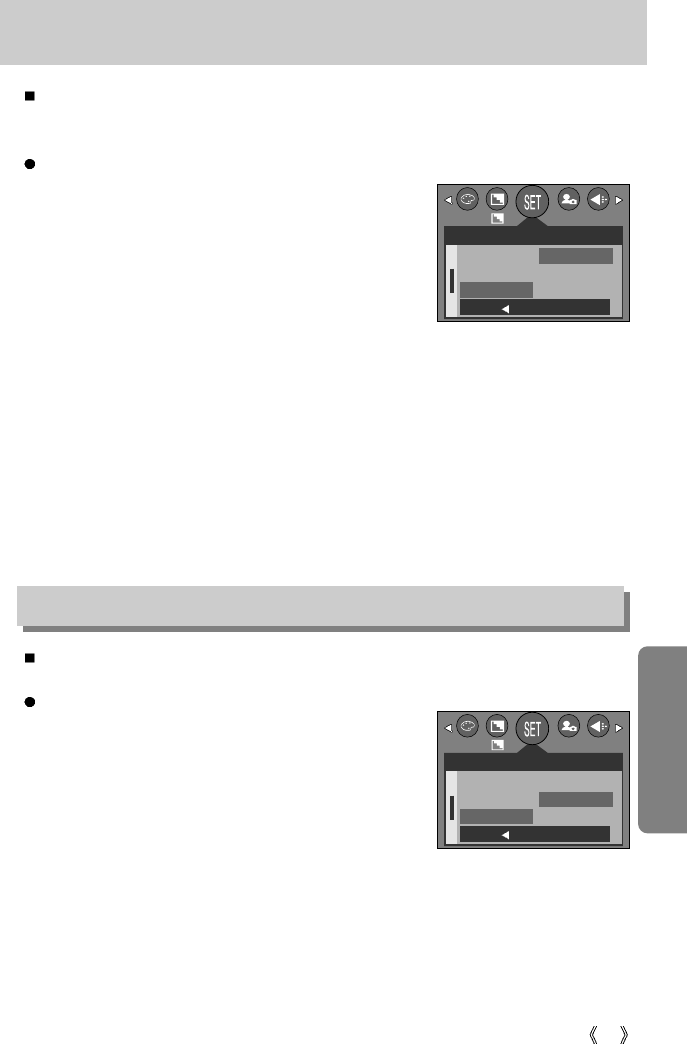
83
Sound
If you set the operation sound to ON, various sounds will be activated for camera startup,
when button are pressed, and if there is a card error, so that you can be aware of the camera
operation status.
Setting Operation Sounds
1. In any mode with the exception of Voice Recording mode,
press the MENU button.
2. Press the LEFT/ RIGHT button and select the [SETUP]
menu tab.
3. Select the [SOUND] menu by pressing the UP/ DOWN
button and press the RIGHT button.
4. Select a desired sub menu by pressing the UP/ DOWN
button and press the OK button.
[SOUND] sub menu : OFF/ LOW/ MEDIUM/ HIGH
5. Press the menu button twice and the menu will disappear.
You can adjust the LCD brightness.
Adjusting LCD Brightness
1. In any mode with the exception of Voice Recording mode,
press the MENU button.
2. Press the LEFT/ RIGHT button and select the [SETUP]
menu tab.
3. Select the [LCD] menu by pressing the UP/ DOWN button
and press the RIGHT button.
4. Select a desired sub menu by pressing the UP/ DOWN
button and press the OK button.
[LCD] sub menu : DARK, NORMAL, BRIGHT
5. Press the menu button twice and the menu will disappear.
LCD brightness
SETUP
D & TIME
IMPRINT
SOUND
BACK: SET:OK
OFF
LOW
MEDIUM
SETUP
IMPRINT
SOUND
LCD
BACK: SET:OK
DARK
NORMAL
BRIGHT
NOR 2816
NOR 2816
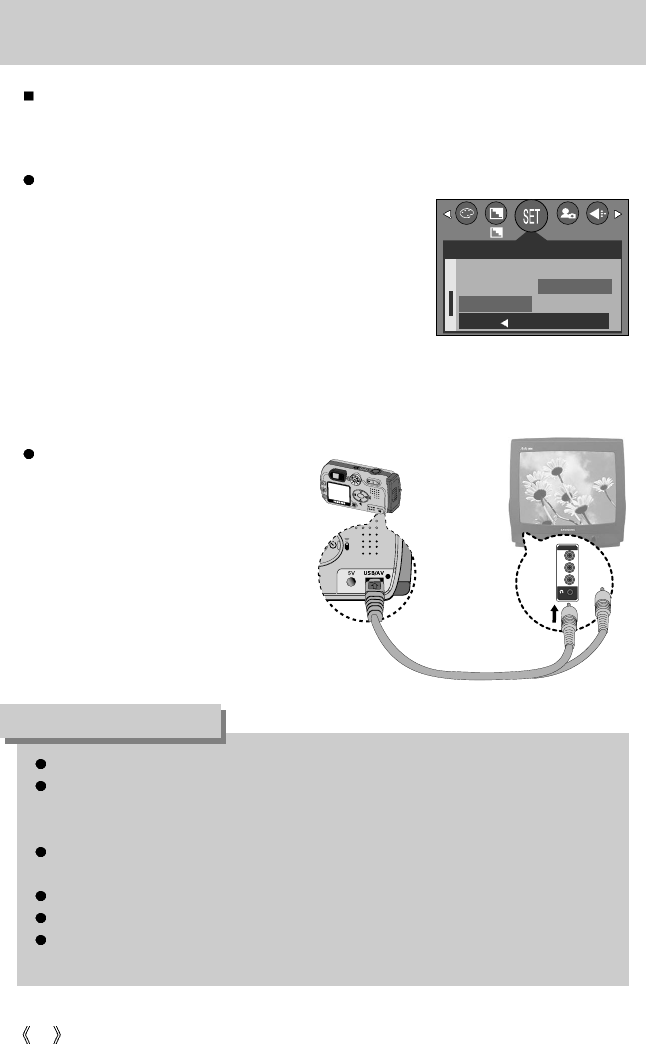
84
Selecting Video out type
The Movie output signal from the camera can be NTSC or PAL.
Your choice of output will be governed by the type of device (monitor or TV, etc.) to which the
camera is connected. PAL mode can support only BDGHI.
Setting the Video Out Type
1. In any mode with the exception of Voice Recording mode,
press the MENU button.
2. Press the LEFT/ RIGHT button and select the [SETUP]
menu tab.
3. Select the [VIDEO] menu by pressing the UP/ DOWN
button and press the RIGHT button.
4. Select a desired sub menu by pressing the UP/ DOWN
button and press the OK button.
[VIDEO] sub menu : NTSC, PAL
5. Press the menu button twice and the menu will disappear.
NTSC : U.S.A, Canada, Japan, South Korea, Taiwan, Mexico.
PAL : Australia, Austria, Belgium, China, Denmark, Finland, Germany, U.K., Holland,
Italy, Kuwait, Malaysia, New Zealand, Singapore, Spain, Sweden, Switzerland,
Thailand, Norway.
When using a TV as an external monitor, you will need to select the external or AV
channel of the TV.
There will be a digital noise on the external monitor, but it is not a malfunction.
If the image is not in the centre of the screen, use the TV controls to centre it.
When the camera is connected to an external monitor, the menu will be visible on the external
monitor and the menu functions are the same as those indicated on the LCD monitor.
INFORMATION
Connecting to an external monitor
In RECORDING/ PLAY mode, you can
view the stored still images or movie clips
by connecting the camera to an external
monitor via the A/V cable. When the
camera is connected to an external
monitor, the LCD monitor will be turned
off automatically. Yellow color-Video
White color-Voice
SETUP
SOUND
LCD
VIDEO
BACK: SET:OK
NTSC
PAL
NOR 2816
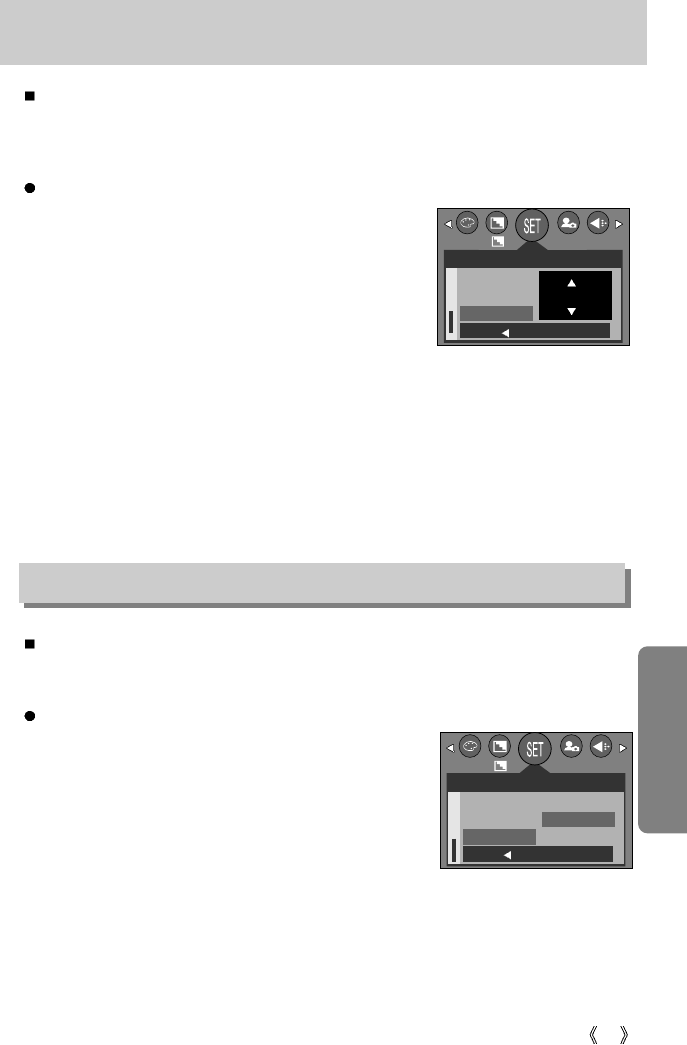
85
Quick view
If you enable Quick View before capturing an image, you can view the image you just
captured on the LCD monitor for the duration set in the [Q.VIEW] setup. Quick view is
possible only with still images.
Setting Quick View
1. In any mode with the exception of Voice Recording mode,
press the MENU button.
2. Press the LEFT/ RIGHT button and select the [SETUP]
menu tab.
3. Select the [Q.VIEW] menu by pressing the UP/ DOWN
button and press the RIGHT button.
4. Select a desired sub menu by pressing the UP/ DOWN
button and press the OK button.
[OFF] : The quick view function can’t be activated.
[1 ~ 3 SEC] : The captured image is briefly displayed during the selected time.
5. Press the menu button twice and the menu will disappear.
Initialization(RESET ALL)
All camera menu and function settings will be restored to their default values.
However, values for DATE/TIME, LANGUAGE, and VIDEO OUT will not be changed.
Initializing the Camera
1. In any mode with the exception of Voice Recording mode,
press the MENU button.
2. Press the LEFT/ RIGHT button and select the [SETUP]
menu tab.
3. Select the [RESET] menu by pressing the UP/ DOWN
button and press the RIGHT button.
4. Select a desired sub menu by pressing the UP/ DOWN
button and press the OK button.
If [NO] is selected : Settings will not be restored to their defaults.
If [YES] is selected : All settings will be restored to their defaults.
5. Press the menu button twice and the menu will disappear.
SETUP
LCD
VIDEO
Q. VIEW
BACK: SET:OK
1 SEC
SETUP
VIDEO
Q. VIEW
RESET
BACK: SET:OK
NO
YES
NOR 2816
NOR 2816
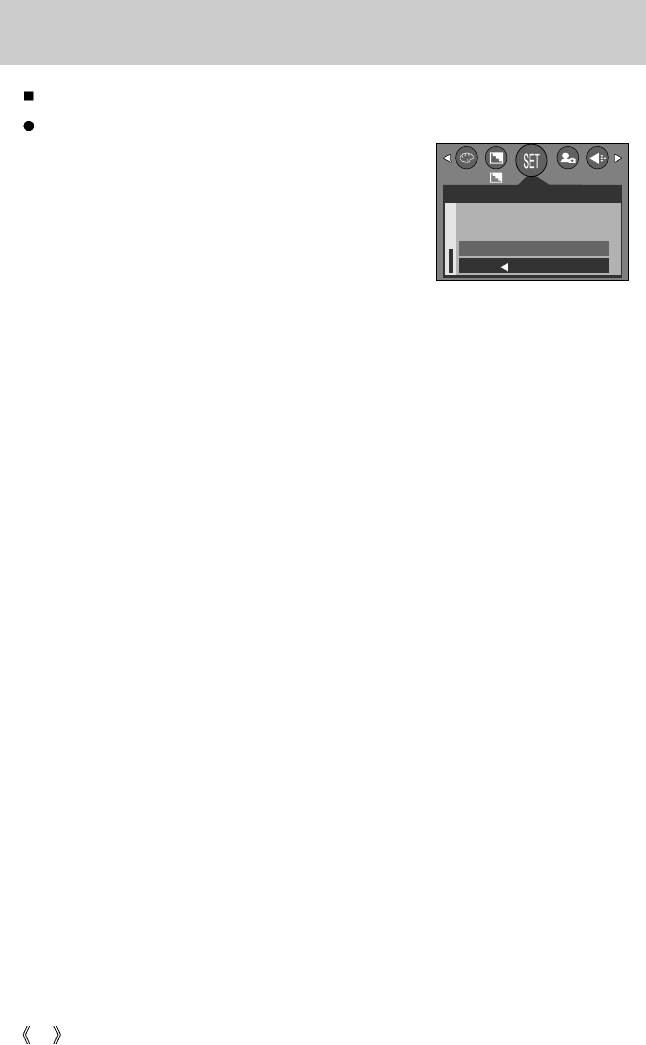
86
Connecting an External Device (USB)
You can select an external device to which you want to connect the camera using the USB cable.
Selecting an External Device
1. In any mode with the exception of Voice Recording mode,
press the MENU button.
2. Press the LEFT/ RIGHT button and select the [SETUP]
menu tab.
3. Select the [USB] menu by pressing the UP/ DOWN button
and press the RIGHT button.
4. Select a desired sub menu by pressing the UP/ DOWN
button and press the OK button.
[COMPUTER] : Select this if you want to connect the camera to your PC.
Refer to page 105 for instructions on how to connect the camera to your
PC.
[PRINTER] : Select this if you want to connect the camera to your printer.
Refer to page 73 for instructions on how to connect the camera to your
printer.
5. Press the menu button twice and the menu will disappear.
SETUP
Q. VIEW
RESET
USB
BACK: SET:OK
COMPUTER
PRINTER
NOR 2816
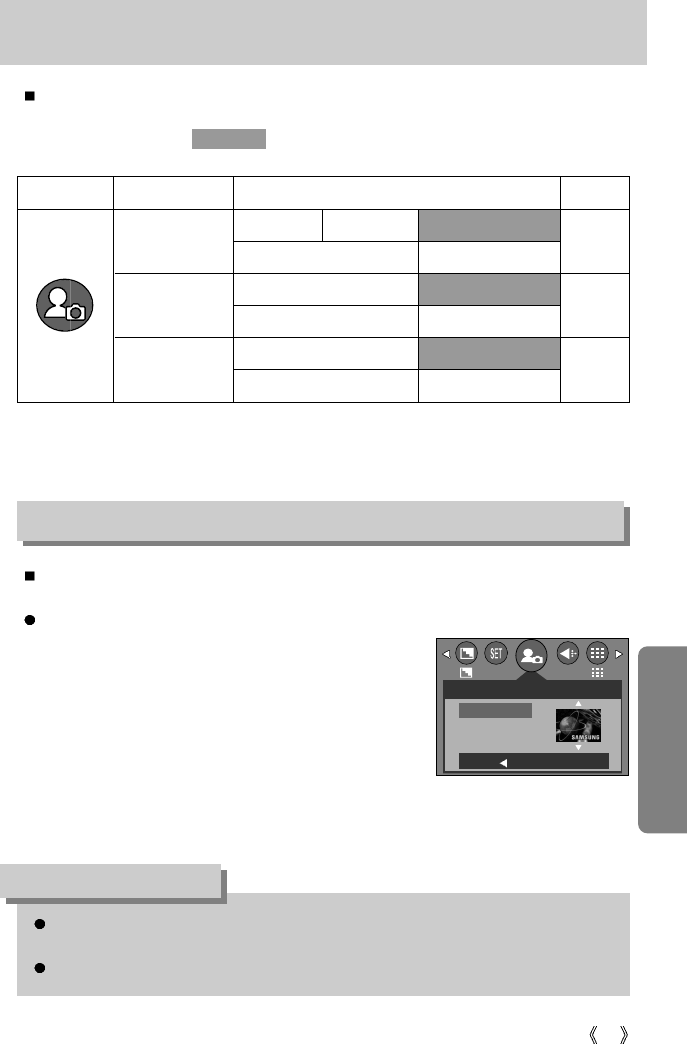
87
Setting up the MYCAM menu
You can set up a start up image, start up sound and shutter sound. Every camera working
mode (with the exception of Voice recording mode) has the MyCAM menu.
The items indicated by are default settings.
Menu tab Main menu Sub menu Page
IMAGE 1
IMAGE 2 IMAGE 3
OFF SOUND 1
SOUND 2 SOUND 3
OFF SOUND 1
SOUND 2 SOUND 3
S.IMAGE
S.SOUND
SH.SOUND
p.87
p.88
p.88
You can select the image that is first displayed on the LCD monitor whenever the camera is
turned on.
Setting a Startup Image
1. In any mode with the exception of Voice Recording mode,
press the MENU button.
2. Press the LEFT/ RIGHT button and select the [MYCAM]
menu tab.
3. Select the [S.IMAGE] menu by pressing the UP/ DOWN
button and press the RIGHT button.
4. Select a desired sub menu by pressing the UP/ DOWN
button and press the OK button.
5. Press the menu button twice and the menu will disappear.
Start up image
Use a saved image for the start-up image with the [LOGO] in the [RESIZE] menu in the
play mode.
The start-up image will not be deleted by deleting all images or [FORMAT] menu.
INFORMATION
OFF
USER IMAGE
* Menus are subject to change without prior notice.
MYCAM
S.IMAGE
S.SOUND
SH.SOUND
BACK: SET:OK
2816
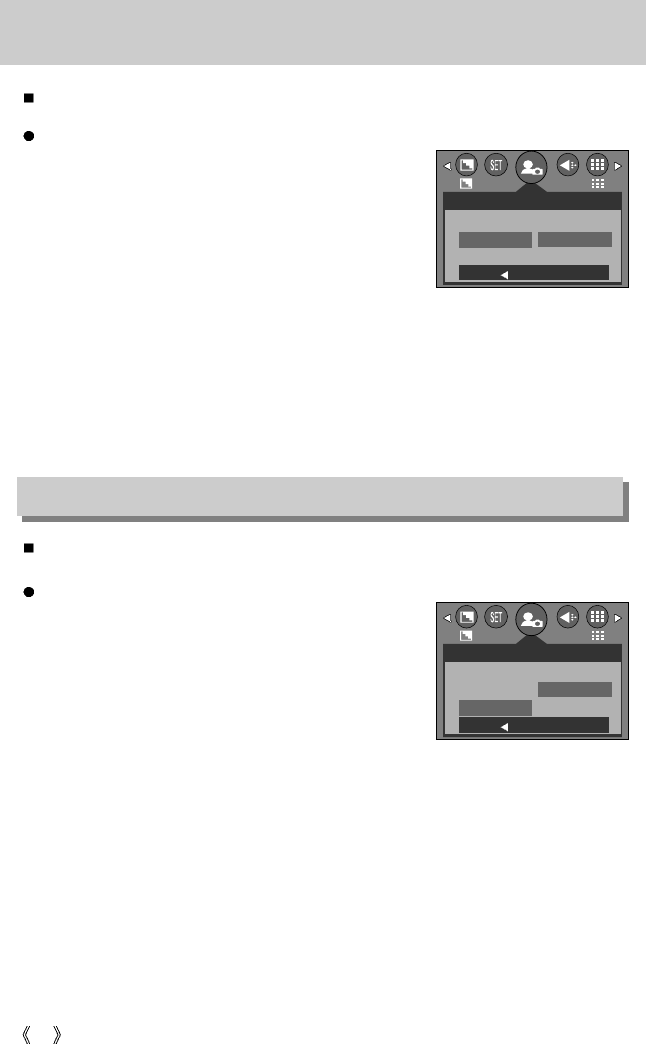
88
Start up sound
You can select the shutter sound.
Selecting the Shutter Sound
1. In any mode with the exception of Voice Recording mode,
press the MENU button.
2. Press the LEFT/ RIGHT button and select the [MYCAM]
menu tab.
3. Select the [SH.SOUND] menu by pressing the UP/
DOWN button and press the RIGHT button.
4. Select a desired sub menu by pressing the UP/ DOWN
button and press the OK button.
5. Press the menu button twice and the menu will disappear.
Shutter sound
Setting the Startup Sound
1. In any mode with the exception of Voice Recording mode,
press the MENU button.
2. Press the LEFT/ RIGHT button and select the [MYCAM]
menu tab.
3. Select the [S.SOUND] menu by pressing the UP/ DOWN
button and press the RIGHT button.
4. Select a desired sub menu by pressing the UP/ DOWN
button and press the OK button.
5. Press the menu button twice and the menu will disappear.
MYCAM
S.IMAGE
S.SOUND
SH.SOUND
BACK: SET:OK
OFF
SOUND 1
SOUND 2
MYCAM
S.IMAGE
S.SOUND
SH.SOUND
BACK: SET:OK
OFF
SOUND 1
SOUND 2
You can select the sound that is activated whenever the camera is turned on.
2816
2816

89
Important notes
Be sure to observe the following precautions!
This unit contains precision electronic components. Do not use or store this unit in the
following locations.
- Areas exposed to severe changes in temperature and humidity.
- Areas exposed to dust and dirt.
- Areas exposed to direct sunlight or the inside of a vehicle in hot weather.
- Environments where there is high magnetism or excessive vibration.
- Areas with high explosives or highly flammable materials.
Do not let the unit come into contact with dust, vinyl goods, or chemicals, such as
insecticides, for an extended period of time.
Sand can be particularly troublesome to cameras.
- Do not let sand get inside the unit when using it on beaches, coastal dunes, or other areas
where there is lots of sand.
- Doing so may result in failure or may permanently render the unit unusable.
Extremes in temperature may cause problems.
- If the camera is transferred from a cold to a warm and humid environment, condensation
can form on the delicate electronic circuitry. If this occurs, turn the camera off and wait for at
least 1 hour until all moisture is dispersed. Moisture build up can also occur in the memory
card. If this happens, turn off the camera and remove the memory card. Wait until the
moisture has dispersed.
Caution on Using the Lens
- If the lens is subjected to direct sunlight, it could result in discoloration and deterioration of
the image sensor.
- Pay attention not to get fingerprints or foreign substances on the surface of the lens.
If the digital camera is not used for a long period, an electric discharge can occur.
It is a good idea to remove the batteries and the memory card if you do not intend using the
camera for an extended period of time.
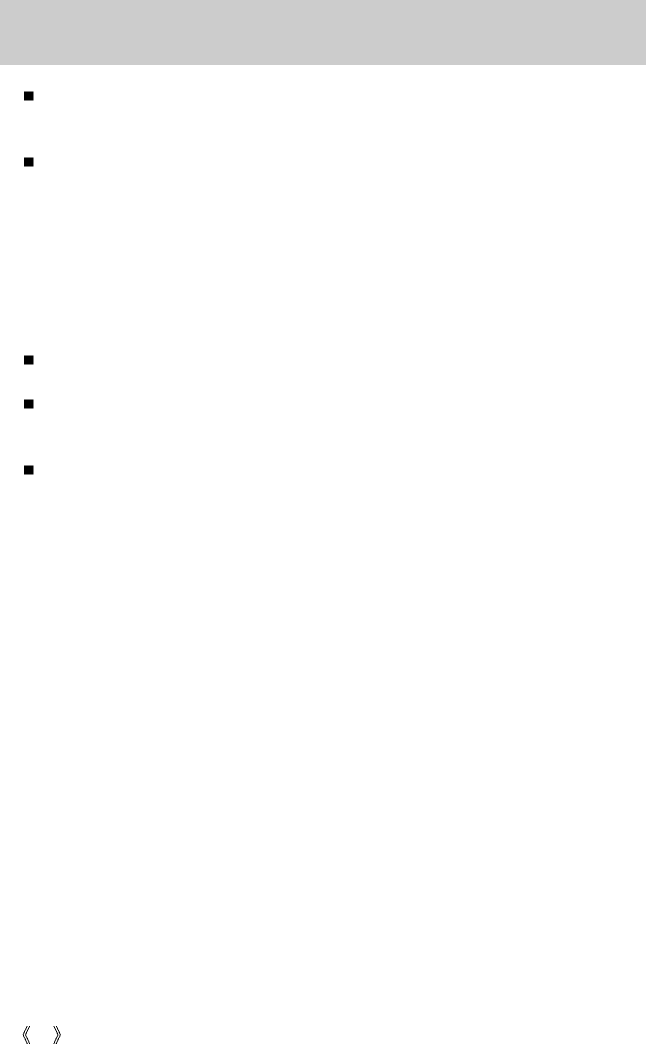
90
Important notes
If the camera is exposed to an electronic interference, it will turn itself off to protect the
memory card.
Camera Maintenance
- Use a soft brush (available from photo stores) to gently clean the lens and LCD assemblies.
If this does not work, lens-cleaning paper with lens cleaning fluid can be used.
Clean the camera body with a soft cloth. Do not allow this camera to come into contact with
solvent materials such as benzol, insecticide, thinners etc. This may damage the body shell
of the camera and also affect its performance. Rough handling can damage the LCD
monitor. Take care to avoid damage and keep the camera in its protective carry case at all
times when not in use.
Do not attempt to disassemble or modify the camera.
Under certain conditions, static electricity can cause the flash unit to fire. This is not harmful to
the camera and is not a malfunction.
When images are uploaded or downloaded, the data transfer may be affected by static
electricity. In this case, disconnect and re-connect the USB cable before trying the transfer
again.
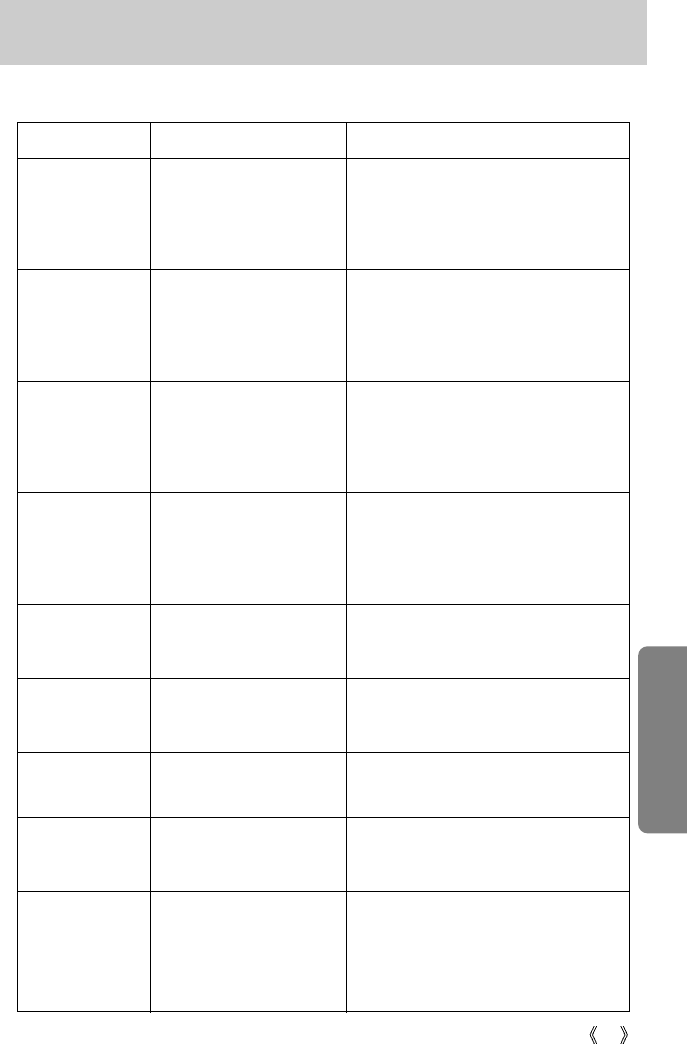
91
Warning indicator
Warning indicator Causes Remedy
There are several warnings that may appear on the LCD display
-
Turn off the camera power and turn it on again
- Insert the memory card again
- Format the memory card (p.81)
- Memory card error
- There is insufficient memory
capacity to take an image
- There are no images stored
on the memory card
- A memory card is not inserted
- The camera can’t recognize
the memory card
- File error
- Memory card error
- There is low battery capacity
- The memory card is locked
CARD ERROR !
CARD FULL !
NO IMAGE !
NO CARD !
FILE ERROR !
LOW BATTERY !
CARD LOCKED !
- Insert a new memory card
- Delete unnecessary image files to free up
some memory
- Take images
- Insert a memory card that is holding some
images
- Insert a memory card
- Insert the memory card again
-
Turn off the camera power and turn it on again
- Format the memory card
- Contact a camera service center
- Insert fresh batteries
- Slide the write protect switch to the top of the
memory card
- When taking pictures in dark
places
LOW LIGHT ! - Use a tripod and take pictures in Flash
Photography mode
- [USB] sub menu and
connected device are not
matched.
SET USB
- Reconfigure [USB] in the [SETUP] menu.
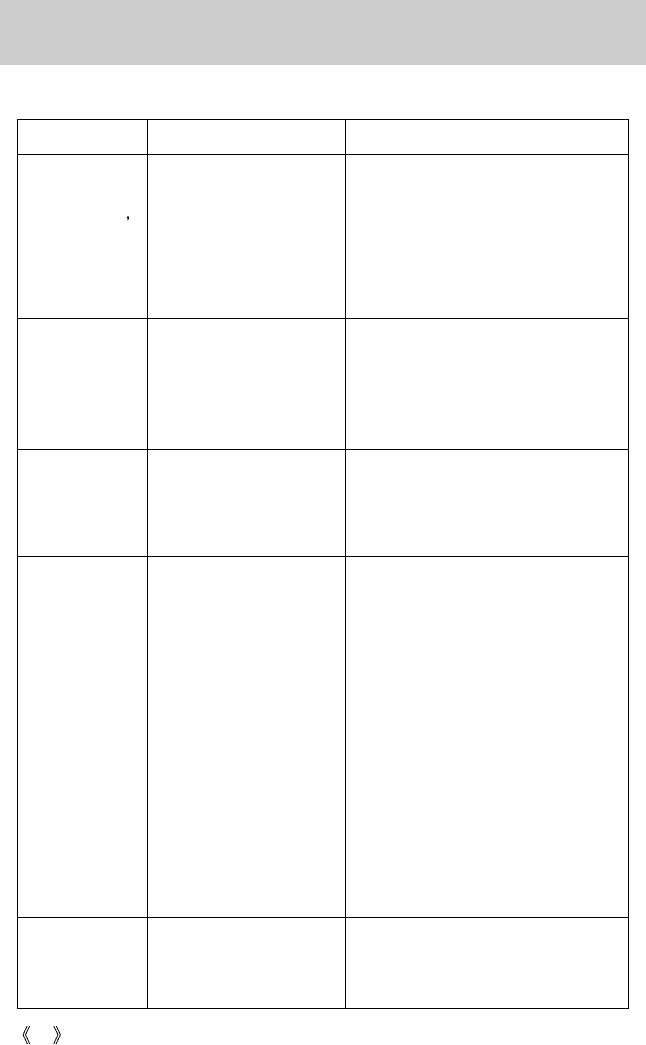
92
Before contacting a service center
Please check the following
Symptom Causes Remedy
- Insert fresh batteries
- Connect an AC Power Adapter
- Insert the batteries according to the polarity
marks (+, -)
- There is low battery capacity
- An AC Power Adapter is not
connected
- Batteries are inserted
incorrectly with the reverse
polarities
- The batteries are exhausted
- The Camera is turned off
automatically
- The Adapter plug is not
connected securely
- The Camera is being used in
low temperatures
- The memory card is not
inserted
- There is insufficient memory
capacity
- The memory card has not
been formatted
- The memory card is exhausted
- The camera’s power is off
- The batteries are exhausted
- The memory card is locked
- Batteries are inserted
incorrectly with the reverse
polarities
The camera doesn t
switch on
The camera power
ceases whilst in use
Batteries drain
quickly
Camera does not
take images when
pressing the
Shutter button
- Insert fresh batteries
- Press the power button to reactivate camera
- Remove and re-insert the plug
- Keep the camera in warm conditions
(i.e. inside a coat or jacket) and only remove it
in order to take images
- After turning the camera off, insert a new
memory card
- Delete unnecessary image files
- Format the memory card (p.81)
- Insert a new memory card
- Turn the camera power on
- Insert fresh batteries
- Refer to [CARD LOCKED!] error message
(p.91)
- Insert the batteries according to the polarity
marks (+, -)
- The camera was stopped due
to a malfunction
The camera
suddenly stops
working while in use
- Remove /re-insert batteries and switch the
camera on
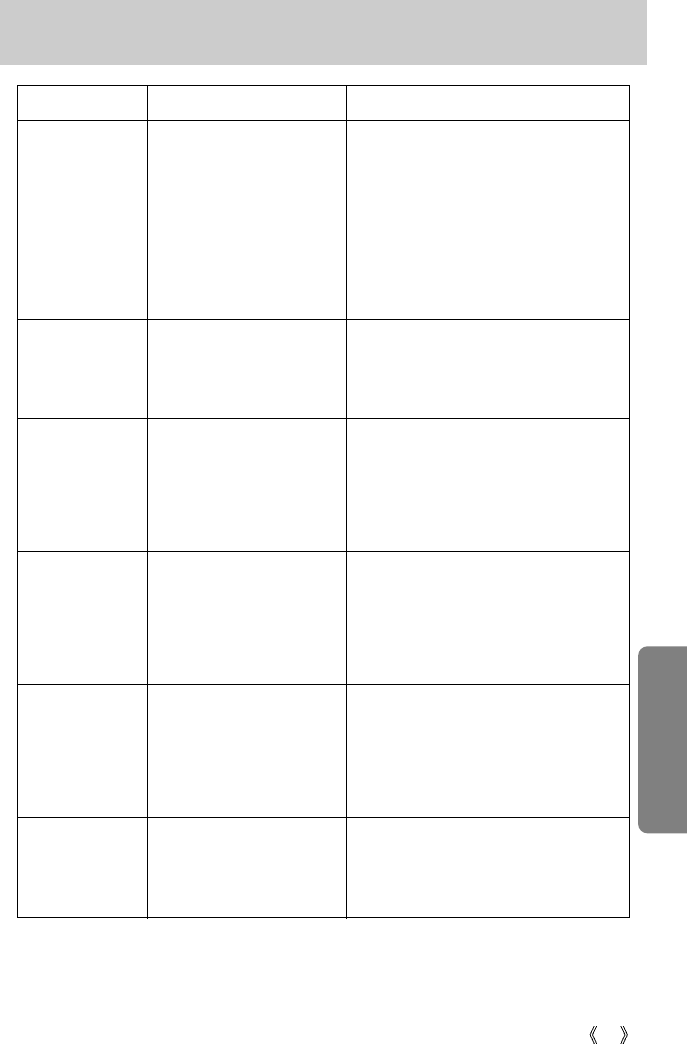
93
Before contacting a service center
Symptom Causes Remedy
- A picture was taken within 0.8
m from the subject without
setting an appropriate macro
mode
- Taking a picture beyond the
flash range
- The lens is smudged or dirty
- Flash off mode has been
selected
The images are
unclear
The flash does not
fire
- If the subject is closer than 0.8m, select
macro shot mode
- Take a picture within the flash range
- Clean the lens
- Dis-engage flash off mode
- Reset the date and time correctly- The date and time have been
set incorrectly or the camera
has adopted the default
settings
- Camera malfunction
- Incorrect memory card format
Incorrect date and
time is displayed
The camera
buttons do not
operate
A card error has
occurred while the
memory card is in
the camera.
- Remove /re-insert batteries and switch the
camera on
- Re-format the memory card (p.81)
- Incorrect file name
(Violation of DCF format)
The images don't
play back
- Do not change the image file name
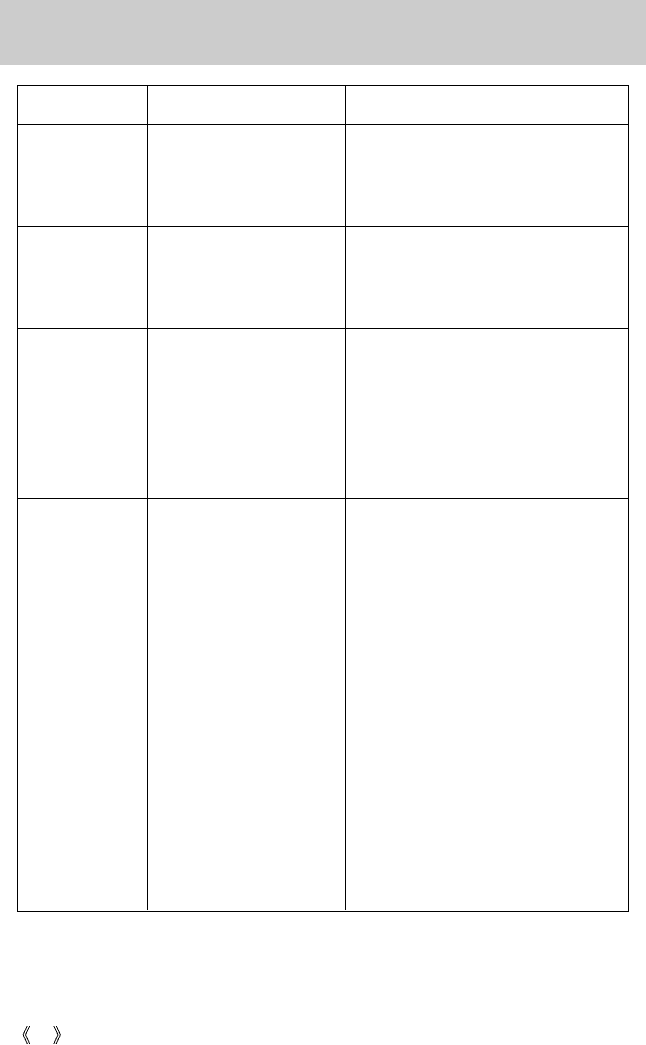
94
Before contacting a service center
Symptom Causes Remedy
- White balance setting is
incorrect
- Exposure is excessive
- Cable connection is incorrect
- The camera is off
- There are no batteries, the
batteries are exhausted or the
AC adapter is not connected.
- The operating system is not
Windows 98, 98SE, 2000, ME,
XP/ Mac OS 9.0~10.2.
Alternatively the PC does not
support USB
- The camera driver is not
installed
Colour of image is
different to the
original scene
Images are too
bright
When using the
PC’s explorer, the
[Removable Disk]
file does not show
- Select appropriate White balance
- Reset exposure compensation
- The external monitor has not
been connected properly with
the camera
- There are incorrect files in the
memory card
No image on
external monitor
- Check the connection cables
- Insert a memory card that has correct files
- Check the connection
- Turn the camera on
- Insert new batteries or check the adapter
connection
- Install Windows 98, 98SE, 2000, ME, XP/
Mac OS 9.0~10.2 to PC that supports USB
- Install a [USB Storage Driver]
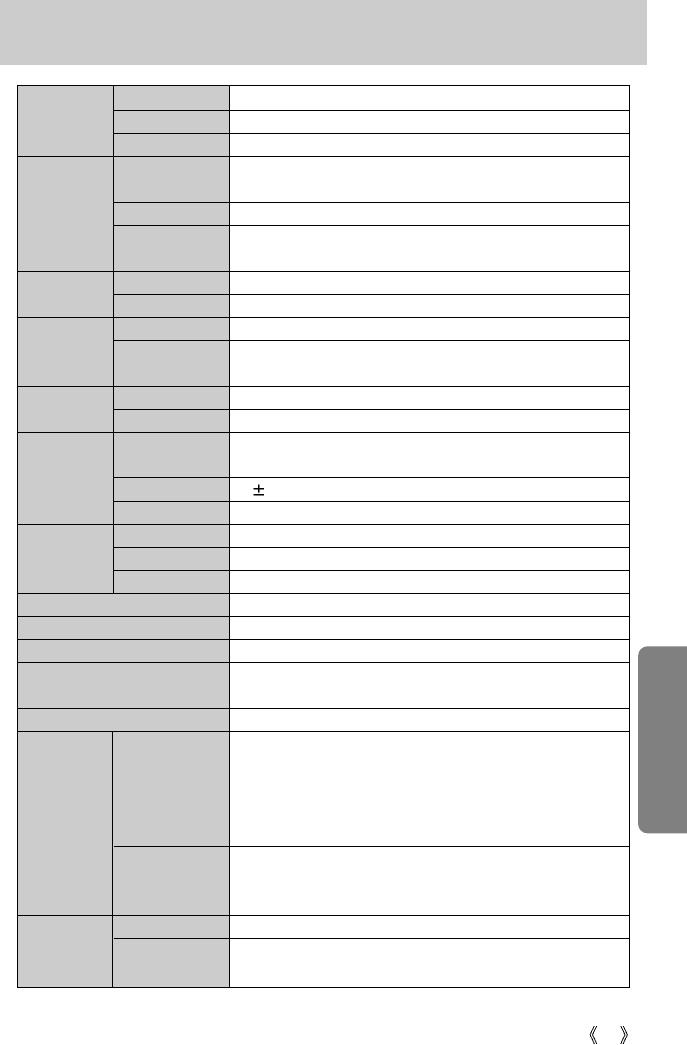
95
Specifications
Type 1/1.8" CCD
Effective Pixel Approx. 6.1 Mega-pixel
Total Pixel Approx. 6.3 Mega-pixel
Schneider Lens f = 7.7 ~ 23.1mm
(35mm film equivalent : 38~114mm)
F No. F2.7 ~ F4.9
Still Image mode : 1.0X ~ 4.0X
Play mode : 1.0X ~ 11X (depends on image size)
Optical Viewfinder
Real image optical viewfinder
LCD Monitor 1.5" color TFT LCD
Type TTL auto focus, Manual focus
Normal : 80cm ~ infinity
Macro : 30 ~ 80cm, Super Macro : 6 ~ 30cm (Wide only)
Type Mechanical and Electronic shutter
Speed 1 ~ 1/2,000 sec. (Manual, Night Mode : 16 ~ 1/2,000 sec.)
Program AE, Shutter Priority AE, Aperture Priority AE or Manual Exposure
Metering : Multi, Spot
Compensation 2EV (0.5EV steps)
ISO Equivalent Auto, 50, 100, 200, 400
Modes
Auto, Auto & Red-eye reduction, Slow sync, Fill-in flash, Flash off
Range Wide : 0.3 ~ 3.0m, Tele : 0.3 ~ 2.0m
Recharging Time Approx. 7 sec.
Sharpness Soft, Normal, Vivid
Effect Normal, B&W, Sepia, RGB
White Balance
Auto, Daylight, Cloudy, Fluorescent H, Fluorescent L, Tungsten, Custom
Voice Recording (max. 1 hours)
Voice Memo in Still Image (max. 10 sec.)
Date Imprinting Date, Date&Time, Off (user selectable)
Modes : Auto, Program, A,S,M, Night Scene, MySet, Scene
*
Scene : Portrait, Children, Landscape, Close-up, Sunset,
Dawn, Backlight, Fireworks, Beach & Snow
Continuous : Single, Continuous
Self-timer : 2 sec., 10 sec., Remocon
With Audio (recording time : memory capacity dependent)
Size : 640x480, 320x240
Frame rate : 30 fps, 15 fps
Media SD / MMC Card (up to 512MB guaranteed)
Still Image : TIFF, JPEG (DCF), EXIF 2.2, DPOF 1.1, PictBridge 1.0
Movie Clip : AVI (MJPEG) Voice : WAV
Image
Sensor
Lens
Focal Length
Range
Control
Digital Zoom
Viewfinder
Focusing
Shutter
Exposure
Flash
Voice Recording
Shooting
Storage
Movie Clip
File Format
Still Image
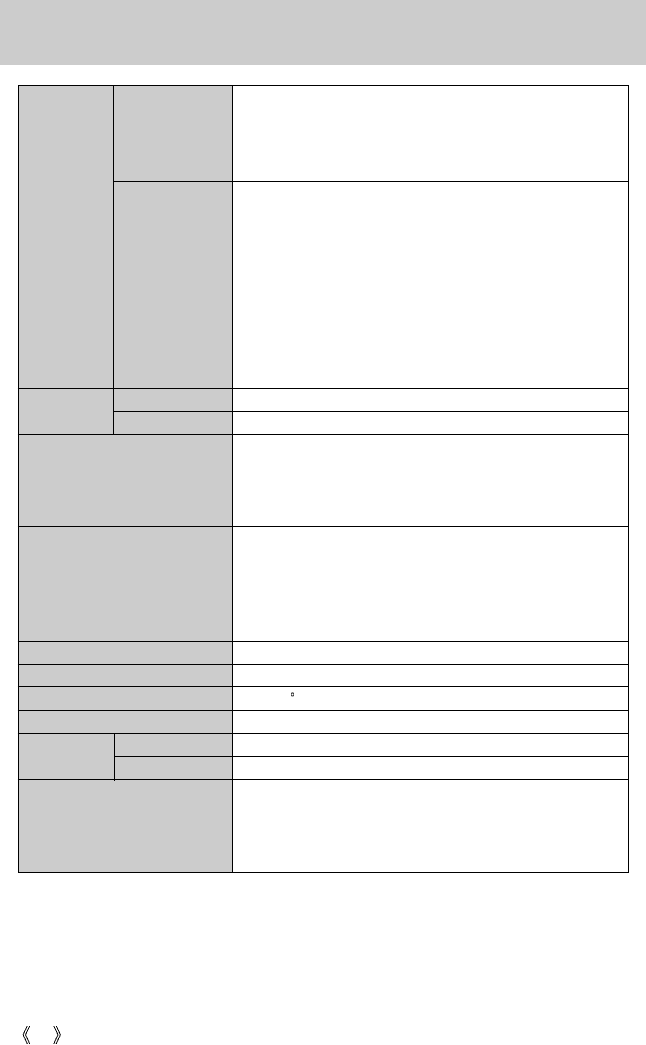
96
Specifications
2816 : 2816x2112 2560 : 2560x1920
2272 : 2272x1704 2048 : 2048x1536
1600 : 1600x1200 1024 : 1024x768
640 : 640x480
2816 : Super Fine 9, Fine 18, Normal 26, TIFF 1
2560 : Super Fine 11, Fine 22, Normal 32, TIFF 2
2272 : Super Fine 14, Fine 28, Normal 40, TIFF 2
2048 : Super Fine 17, Fine 33, Normal 49, TIFF 3
1600 : Super Fine 28, Fine 53, Normal 75, TIFF 5
1024 : Super Fine 64, Fine 106, Normal 139, TIFF 12
640 : Super Fine 129, Fine 201, Normal 227, TIFF 27
*
These figures are measured under Samsung’s standard conditions and
may vary depending on shooting conditions and camera settings.
Single image, Thumbnails, Slide show, Movie Clip
Trimming, Resizing
Digital output connector : USB 1.1
Audio : Mono
Video output : NTSC, PAL (user selectable)
DC power input connector : 5.0V
Primary battery : 2 x AA alkaline, Lithium, Ni-Mn, Ni-Zn / 1 x CR-V3
Rechargeable battery : 3.7V Li-ion(SLB-1437), 2 x AA Ni-MH,
Ni-Cd / 1 x I-Pack (SBP-1303)
AC Adapter : SAC - 51(DC 5.0V, 2.0A)
* Included power source may vary depending on sales region.
Dimensions (WxHxD) 105.5 x 54.6 x 38 mm
Weight 170g (without batteries and card)
Operating Temperature 0 ~40 C
Operating Humidity 5 ~85%
Storage Driver (Windows98/98SE/2000/ME/XP, Mac OS 9.0 ~ 10.2)
Digimax Viewer, ArcSoft PhotoImpression
A World Unique 9 Different Power Sources
A World Superior Schneider Lens
VGA 30fps Movie Clip
AVI capture on Play Mode
* Specifications are subject to change without prior notice.
* All trademarks are the property of their respective owners.
Capacity
(32MB)
Image Size
Storage
Interface
Image Play Type
Editing
Power Source
Special Features
Software Camera
DriverApplication
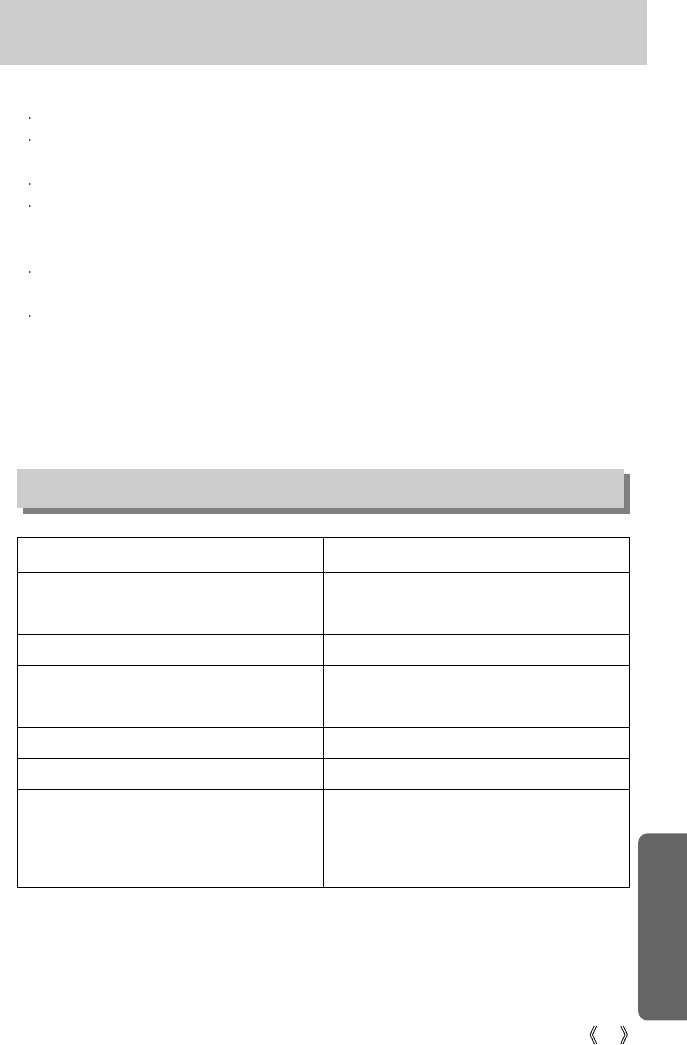
97
Software Notes
Please ensure that you read the instruction manual carefully before use.
The attached software is a camera driver and image editing software tool for Windows.
Under no circumstances should all or part of either the software or the user manual be
reproduced.
Copyrights for software are licensed only for use with a camera.
In the unlikely event of a manufacturing fault, we will repair or exchange your camera.
We cannot, however, be held responsible in any way for damage caused by inappropriate
use.
Using a Hand-made PC or a PC and OS that has not been guaranteed by the manufacturer is
not covered by the Samsung warranty.
Before reading this manual, you should have a basic knowledge of computers and O/S
(Operating Systems).
System Requirements
For Windows For Macintosh
Power Mac G3 or later
Windows 98/98SE/2000/ME/XP Mac OS 9.0 ~ 10.2
Minimum 32MB RAM (XP : 128MB) Minimum 64MB RAM
140MB of available hard-disk space 110MB of available hard-disk space
USB port USB port
CD-ROM drive CD-ROM drive
QuickTime 4.0 or later for Movie Clip
PC with processor better than MMX
Pentium 233MHz (XP : Pentium II 300MHz)
800x600 pixels, 16-bit colour display
compatible monitor (24-bit color display
recommended)
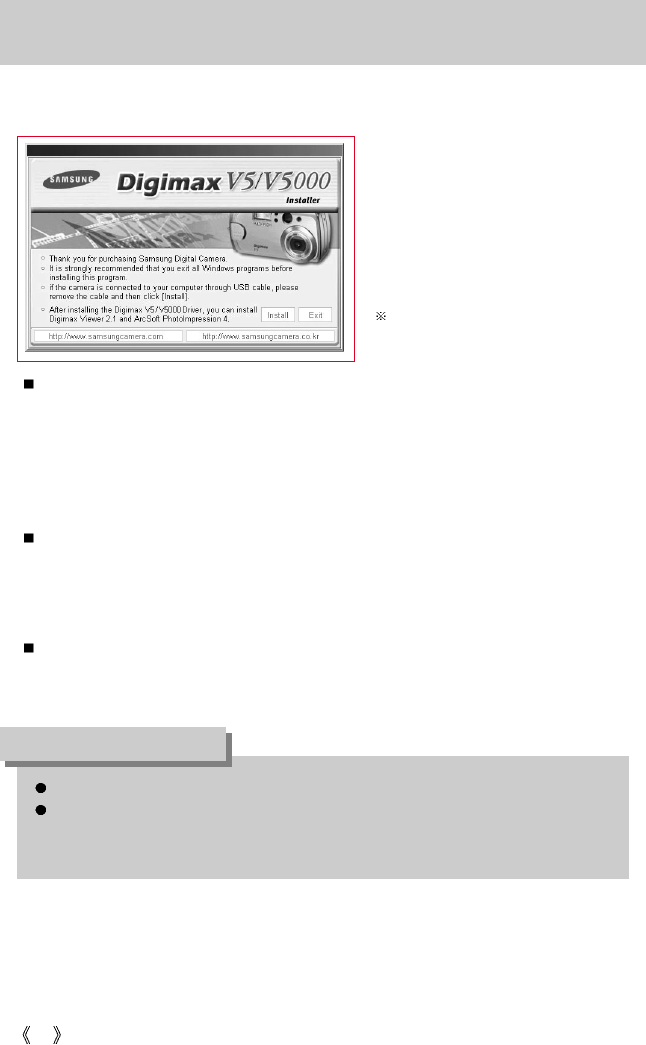
98
About the software
After inserting the CD-ROM provided with this camera into the CD-ROM drive, the following
window should automatically run.
Before connecting the camera to the
PC, you should first install the camera
driver.
Figures (Images) used for the manual
are based on model Digimax V5.
Camera driver : This enables images to transfer between the camera and PC.
This camera uses the USB Storage Driver as the camera driver. You can use the camera as
a USB card reader. After installing the driver and connecting this camera to the PC, you can
find [Removable Disk] in [Windows Explorer] or [My computer]. A USB Storage Driver is
provided only for Windows. A USB Driver for MAC is not included with the Application CD.
But you can use the camera with Mac OS 9.0 ~ 10.2.
Digimax Viewer : This is a program for viewing stored images.
You can see the stored images in the memory directly on a PC monitor. You can also copy,
move or delete the images and enlarge/downscale the image sizes with Digimax Viewer.
This software is only compatible with Windows.
PhotoImpression : Image editing program.
You can edit or store still images that you download from the camera. This software is only
compatible with Windows.
Be sure to check the system requirements (p.97) before installing the driver.
You should allow 5~10 seconds for running the automatic setup program according to the
capability of the computer. If the frame does not show, run the [Windows Explorer] and
select [Samsung.exe] in the CD-ROM Drive root directory.
INFORMATION
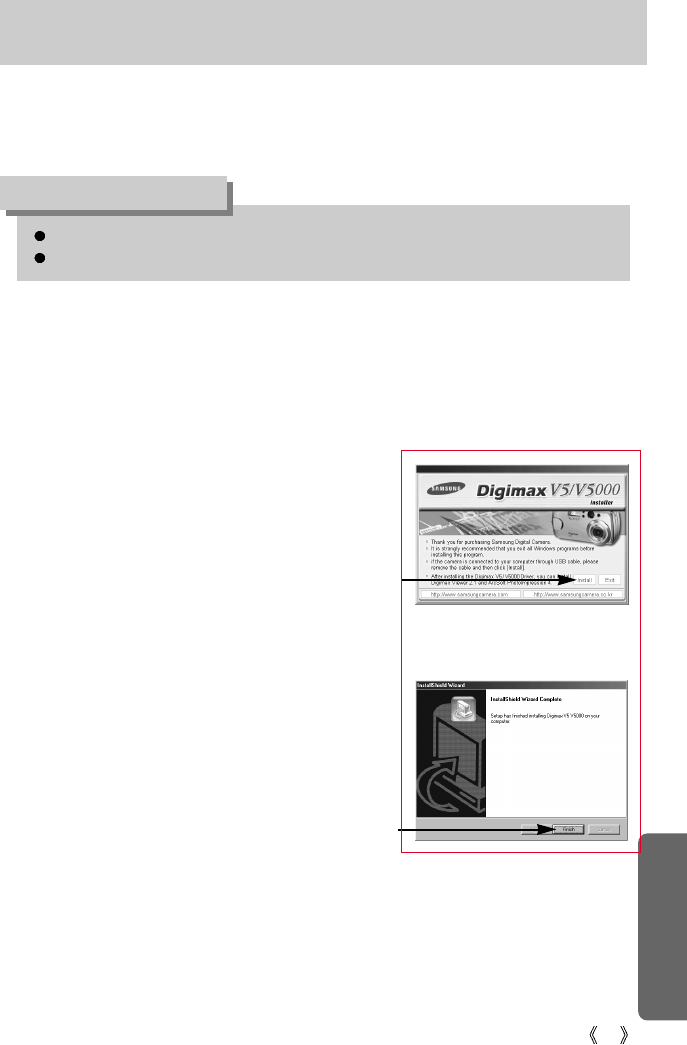
99
Setting up the application software
To use this camera with a PC, install the application software first. After this has been done, the
stored images in the camera can be moved to the PC and can be edited by an image editing
program.
You can visit the Samsung web-site through the internet.
http://www.samsungcamera.com : English
http://www.samsungcamera.co.kr : Korean
Close other programs before installing the application software.
Before installing the application software, disconnect the USB connection.
INFORMATION
1. Click the [Install] menu in the Autorun
frame. The camera driver is installed
automatically.
2. Camera driver installation is complete.
Click the [Finish] button.
[Click!]
[Click!]
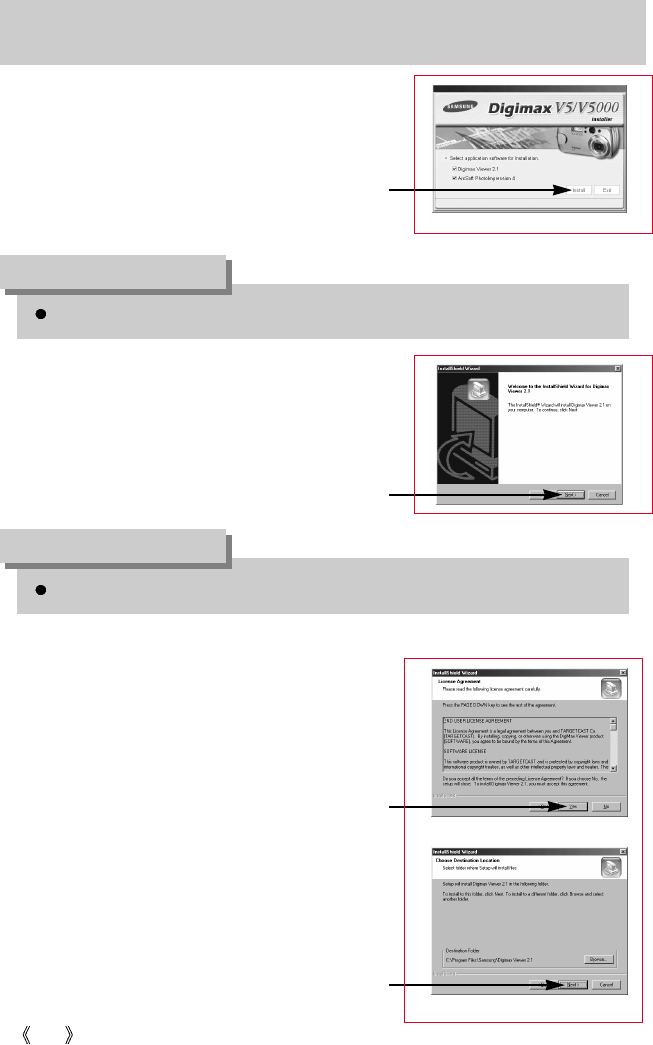
100
Setting up the application software
If you select [Exit] at the step 3, the application program installation will be cancelled.
INFORMATION
If you select [Cancel] at step 4, a window for installing PhotoImpression will be displayed.
INFORMATION
3. A window for which you can select
application software will be displayed.
Select the application program and click
the [Install] button.
Refer to page 98 for more information
about the application program.
4. Install Digimax Viewer.
Click [Next >] button.
5. The Software License Agreement window
will be displayed. If you agree to this, click
[Yes], the window will then move to the
next step. If you disagree, click [No] and
the installation program will be canceled.
6. A destination selection window will open.
Click [Next >]. To copy to the files to
another folder, click [Browse..] and choose
a folder you want.
[Click!]
[Click!]
[Click!]
[Click!]
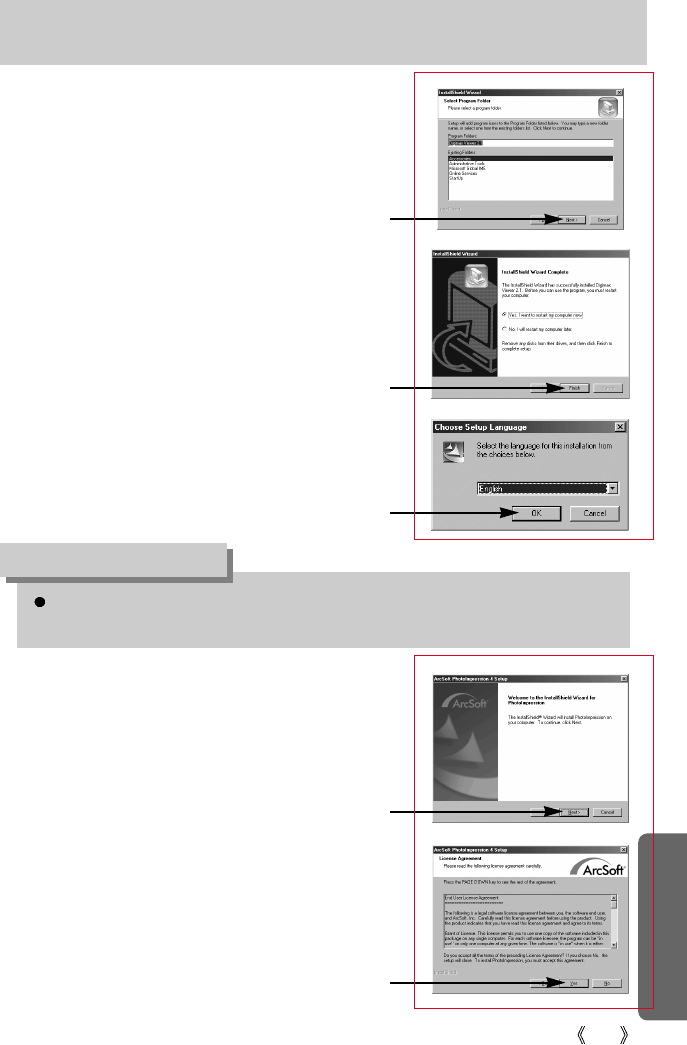
101
Setting up the application software
7. A window will open, asking you to choose
a folder to which program icons will be
added. Click [Next >] button.
If you want to add the program icons to a
different folder, choose another folder, and
then click [Next >] button.
If you click [Cancel] in Step 9, the PhotoImpression installation will be canceled and the
Restart Computer window will appear.
INFORMATION
[Click!]
8. Digimax Viewer installation is successfully
completed. Click the [Finish] button to
install PhotoImpression.The system will
not reboot even the [Yes, I want to restart
the computer now] option is selected.
*The frame 8 may not appear according to
the system requirements. [Click!]
9. Digimax Viewer Installation is completed.
The PhotoImpression installation window
will be displayed as shown alongside.
Click the [OK] button.
[Click!]
10. A Welcome window will be displayed.
Click the [Next >] button.
[Click!]
11. The Software License Agreement
window will be displayed. If you agree to
this, click [Yes], the window will then
move to the next step. If you disagree,
click [No] and the installation program will
be canceled. [Click!]
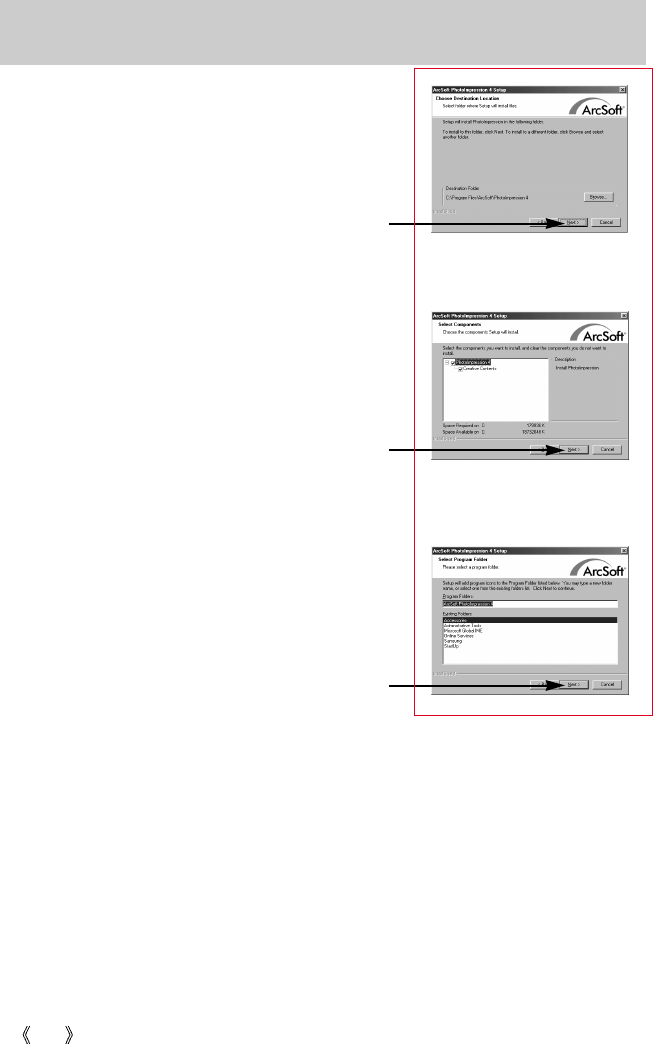
102
Setting up the application software
12. A destination selection window will open.
Click [Next >]. To copy to the files to
another folder, click [Browse...] and
choose a folder you want.
[Click!]
13. The [Select Components] window will
appear. Click [Next >] button.
[Click!]
14. A window will open, asking you to choose
a folder to which program icons will be
added. Click [Next >] button.
If you want to add the program icons to a
different folder, choose another folder,
and then click [Next >] button. [Click!]
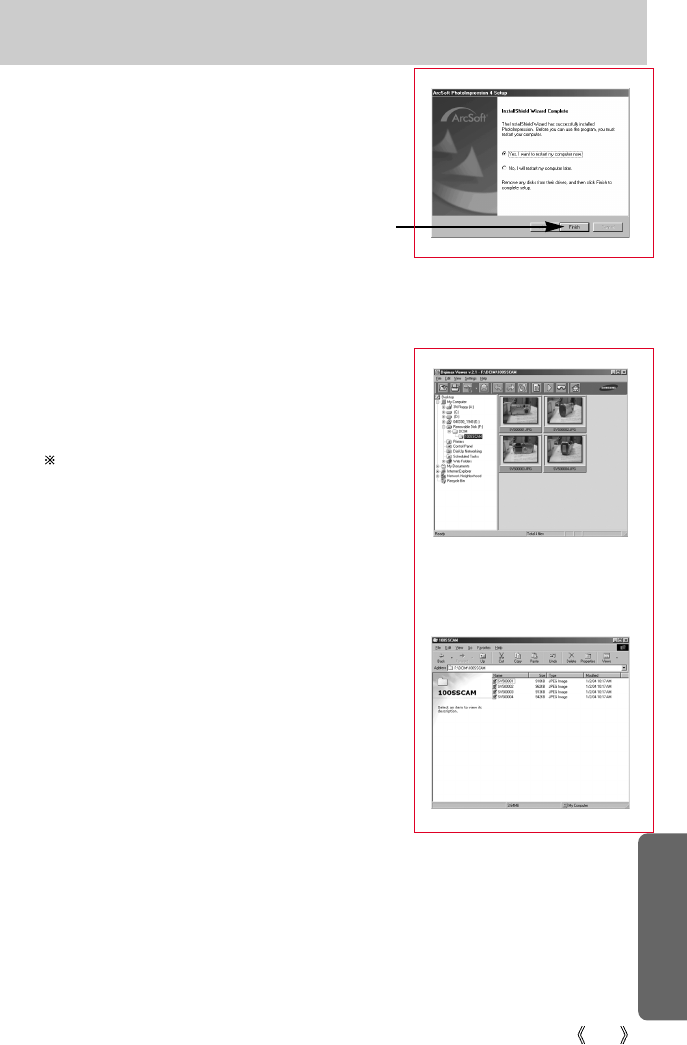
103
Setting up the application software
15. Installation is complete. To apply
changes, you must restart the computer.
Select [Yes, I want to restart my
computer now], and then click [Finish].
16. After restarting the computer, connect the PC to the camera with the USB cable.
18. If you can see [Removable Disk] under
[My computer], the camera driver
installation was successful.
Now you can transfer image files from the
camera to PC via the USB cable.
[Click!]
17. Turn the camera power on. [Found New
Hardware Wizard] will open and the
computer will recognize the camera.
If you have ever installed an image viewer
program or your OS is Windows XP, an
image viewer program will open.
If the image viewer program opens, the
camera driver was setup successfully.
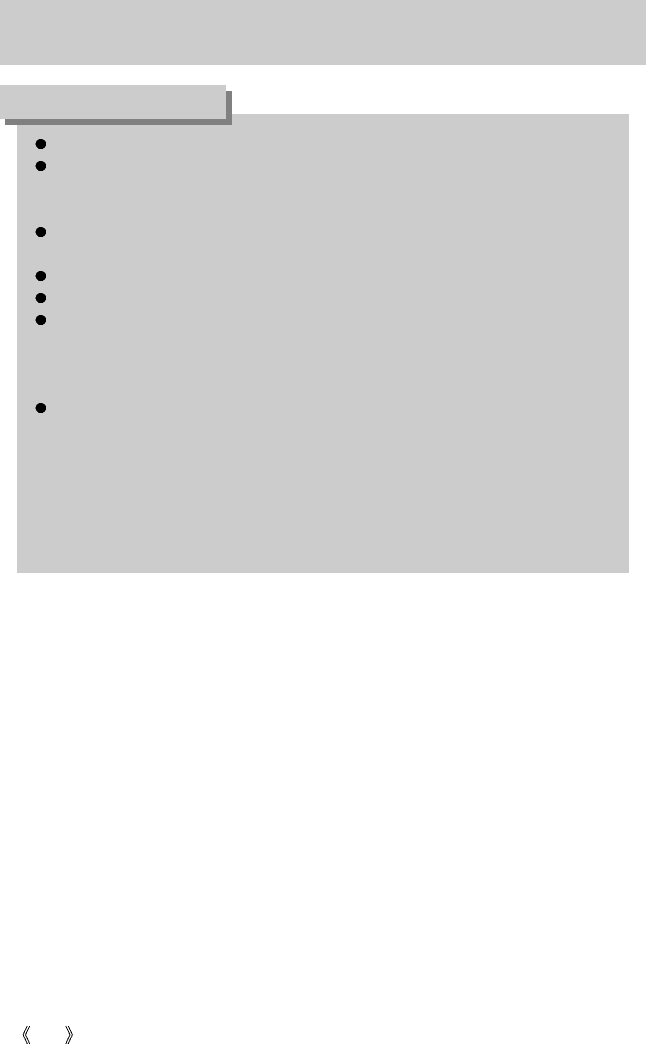
104
Setting up the application software
If you have installed the camera driver, [Found New Hardware Wizard] may not open.
On a Windows 98 or 98 SE system, the Found New Hardware Wizard dialog box opens
and a window asking you to select a driver file may appear. In this case, specify "USB
Driver" in the CD supplied. (for Windows 98 and 98 SE).
When connecting the camera to your PC, it is recommended that you use an AC power
adapter.
Before connecting the camera to the PC, You should first install the camera driver.
After installing the camera driver, you have to restart your PC.
If you connect the camera to the PC before installing the camera driver, the [Found New
Hardware Wizard] will open.
In this case, cancel the [Found New Hardware Wizard] and disconnect the camera. Install
the camera driver and connect the camera to the PC again.
Should the computer not find the camera driver after installation, please try one or more of
the following measures.
1. Delete the camera driver (p.108), and re-install the driver.
2. Refer to FAQ (p.114) to check for a possible solution to the problem.
3. If your PC’s central processing unit is VIA chip (This is shown in the USB Host
Controller), download the patch file from the Samsung Camera web page.
(http://www.samsungcamera.com)
INFORMATION
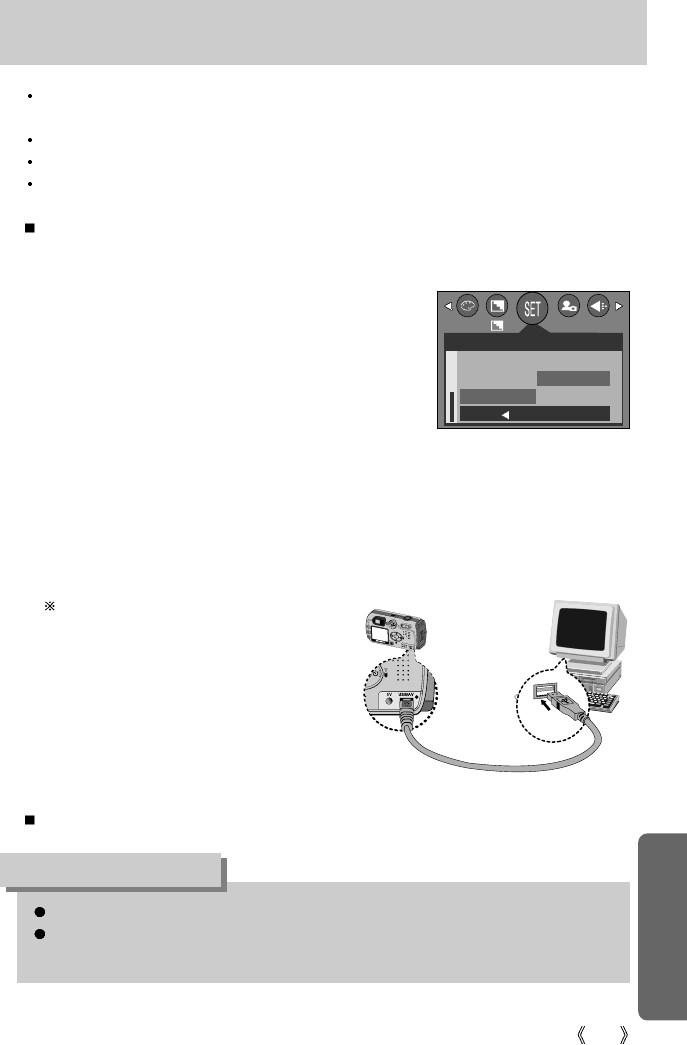
105
Starting PC Mode
The camera driver must be installed before using PC mode.
To save battery power, it is recommended that you use an AC adapter (Optional) when
connecting the camera to a computer.
INFORMATION
If you connect the USB cable to a USB port on your PC and then turn on the power, the
camera will automatically switch to "computer connection mode".
In this mode, you can download stored images to your PC through the USB cable.
The LCD monitor is always turned off in PC mode.
The auto focus lamp will illuminate when the files are transferring via the USB connection.
Connecting the camera to a PC
1. Turn the PC power on.
2. Turn the camera power on.
3. In any mode other than Voice Recording mode, press
the MENU button.
4. Press the LEFT/ RIGHT button and select the [SETUP]
menu tab.
5. Select the [USB] menu by pressing the UP/ DOWN
button and press the RIGHT button.
6. Use the UP and DOWN buttons to select
[COMPUTER], and then press the OK button.
7. Press the menu button twice and the menu will disappear.
8. Connect the PC and the camera via the USB cable.
- Insert the small plug of the USB cable into the camera USB connection terminal.
- Insert the large connector of the USB cable into the USB port of the PC.
- The plugs must be firmly inserted.
Disconnecting the camera and PC : Refer to page 110 (Removing the removable disk).
If you selected [PRINTER] in Step 6,
when you connect the camera to your
computer, the [CONNECTING...]
message will be displayed on the LCD
monitor and the connection will not be
established. In this case, disconnect the
USB cable, and then follow the procedure
from Step 3 and onward.
SETUP
Q. VIEW
RESET
USB
BACK: SET:OK
COMPUTER
PRINTER
NOR 2816
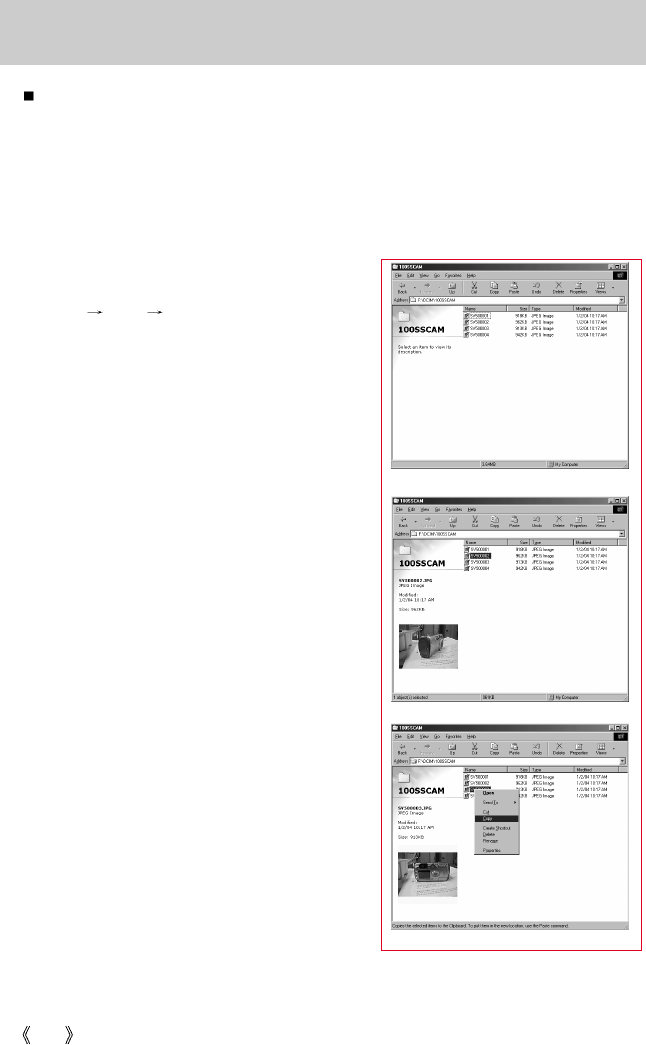
106
Starting PC Mode
3. Select an image and press the right mouse
button.
4. A pop-up menu will open.
Click [Cut] or [Copy] menu.
- [Cut] : cuts a selected file.
- [Copy] : copies files.
Downloading stored images
You can download the still images stored on the camera to your PC's hard disk and print
them or use a photo editing software to edit them.
1. Connect the camera to your PC with the USB cable.
2. On your computer's desktop display, select
[My computer] and double click [Removable
Disk DCIM 100SSCAM].
The image files will then be displayed.
5. Click a folder where you want to paste the file.
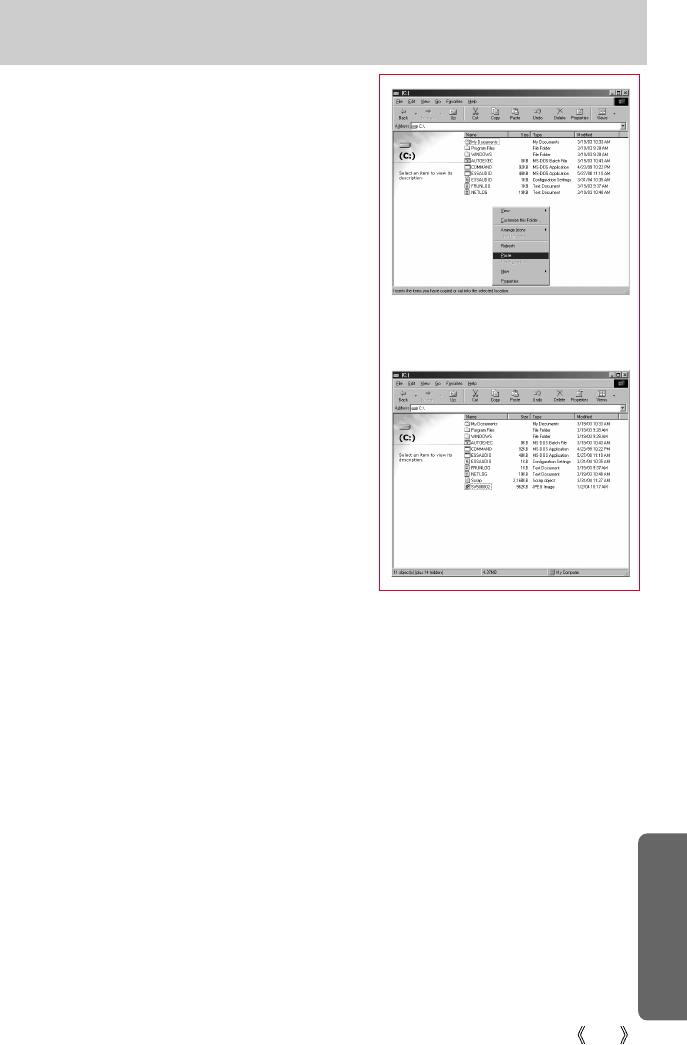
107
Starting PC Mode
6. Press the right mouse button and a pop-up
menu will open. Click [Paste].
7. An image file is transferred from the camera to
your PC.
- By using [Digimax Viewer], you can see the stored images in the memory directly on the PC
monitor and you can copy or move the image files.
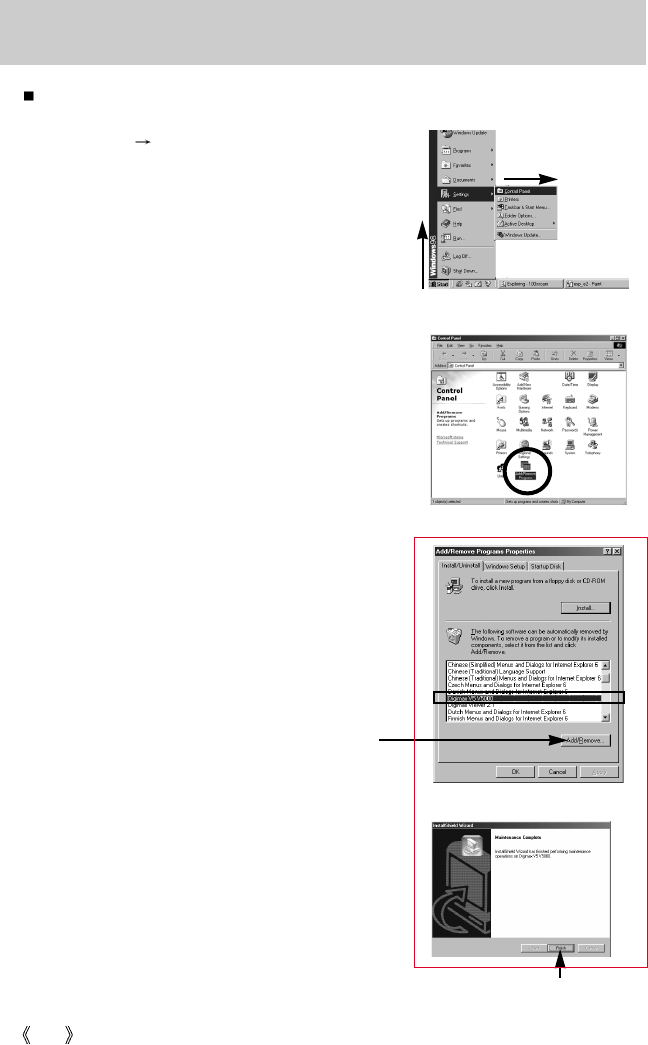
108
Removing the USB Driver for Windows 98SE
To remove the USB driver, refer to the process shown below.
1. Trace [Start Settings] and click [Control Panel].
[Click !]
4. Uninstallation is complete.
Click the [Finish] button and the window will
disappear.
[Click !]
2. Double-click [Add/Remove programs].
3. The [Add/Remove Programs Properties] window
will open. Click [Digimax V6 V6000] and click the
[Add/Remove] button.
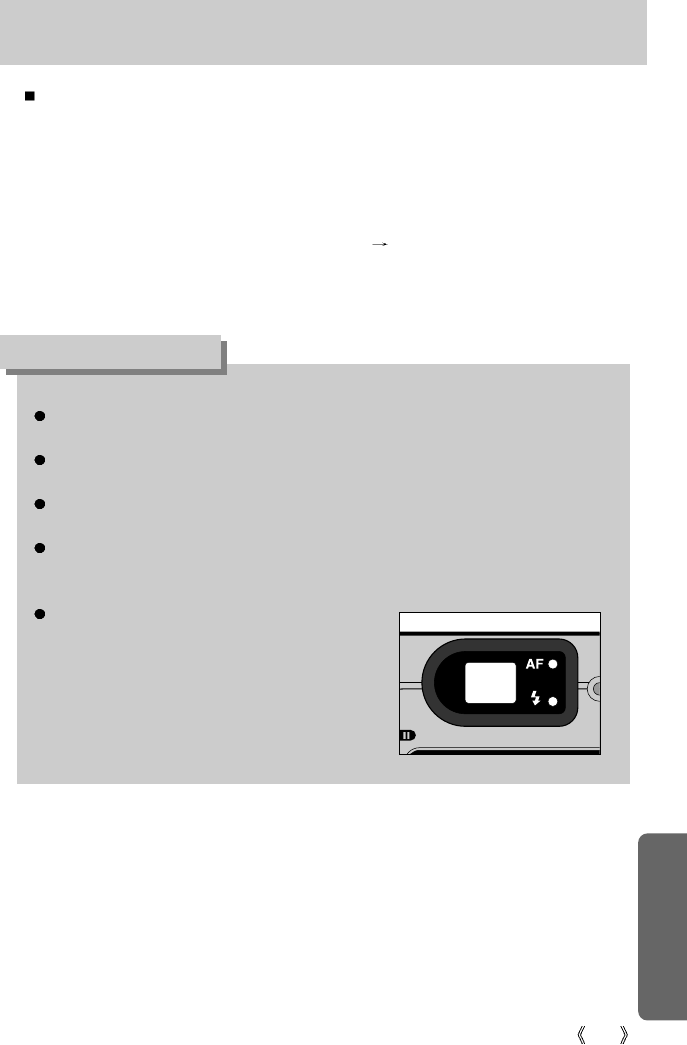
109
Removable Disk
To use this camera as a Removable Disk, install (p.99) the USB Driver.
1. Before turning the camera power on, connect the camera to the PC with the USB cable.
2. Click [Removable Disk] under [My computer] or [Windows Explorer].
3. Image files stored in the Removable Disk (DCIM 100SSCAM) can be transferred to the
PC.
Important information whilst using the Removable Disk
The [Removable Disk] indicator will not show when the camera power is off or the USB
cable is removed.
We recommend that you should copy the images to the PC to view them. Opening
images directly from the removable disk may be subject to unexpected disconnection.
When uploading images from the PC to the camera, ensure that the uploaded file names
are not the same as those already stored on the memory.
When you upload a file that is not taken by this camera to Removable Disk, the [FILE
ERROR!] message will be displayed on the LCD monitor in the PLAY mode, and nothing
is displayed in THUMBNAIL mode.
The auto focus lamp will blink, when a file is
transferred (copy or deletion) between the PC and
the camera. Do not remove the USB cable until
the lamp stops blinking. To remove the USB cable
in Windows 2000/ME/XP, use the [Unplug or Eject
Hardware] icon on the task bar.
INFORMATION
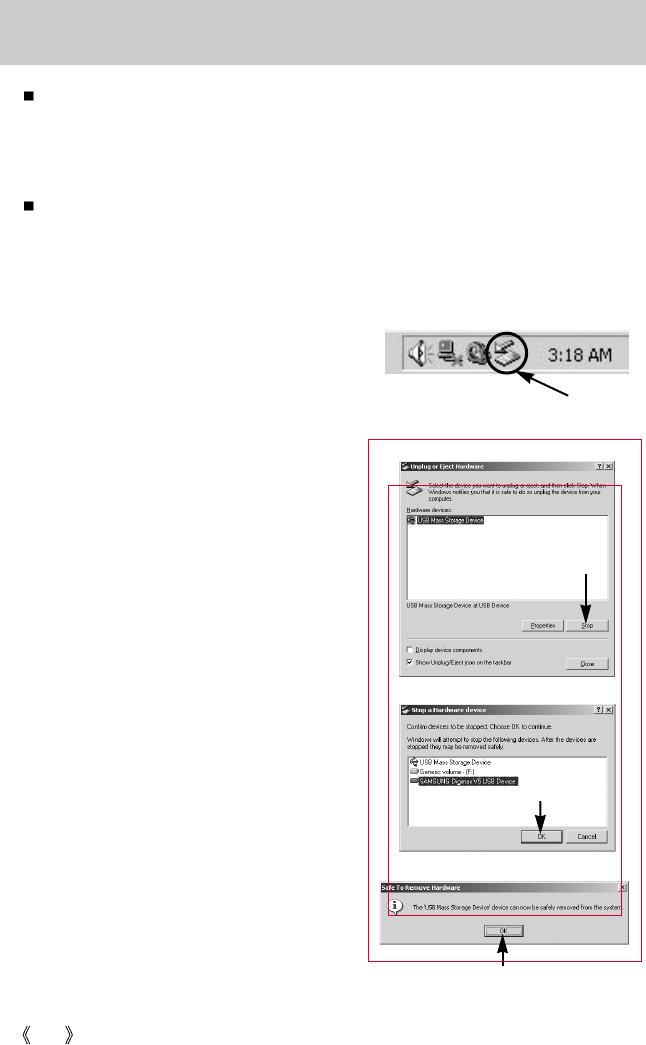
110
Removing the removable disk
[Click!]
[Double-click!]
[Click!]
[Click!]
Windows 98SE
1. Check whether the camera and PC are transferring a file. If the auto focus lamp blinks, you
have to wait until the lamp illuminates.
2. Unplug the USB cable.
Windows 2000/ME/XP
(The illustrations may be different from the real display in accordance with the Windows O/S.)
1. Check whether the camera and PC are transferring a file. If the auto focus lamp blinks, you
have to wait until the lamp illuminates.
2. Double-click the [Unplug or Eject Hardware]
icon on the task bar.
3. The [Unplug or Eject Hardware] window will
open. Select the [USB Mass Storage Device]
and click the [Stop] button.
4. The [Stop a Hardware device] window will
open. Select the [SAMSUNG Digimax V5
USB Device] and click the [OK] button.
5. A [Safe to Remove Hardware] window will
open. Click the [OK] button.
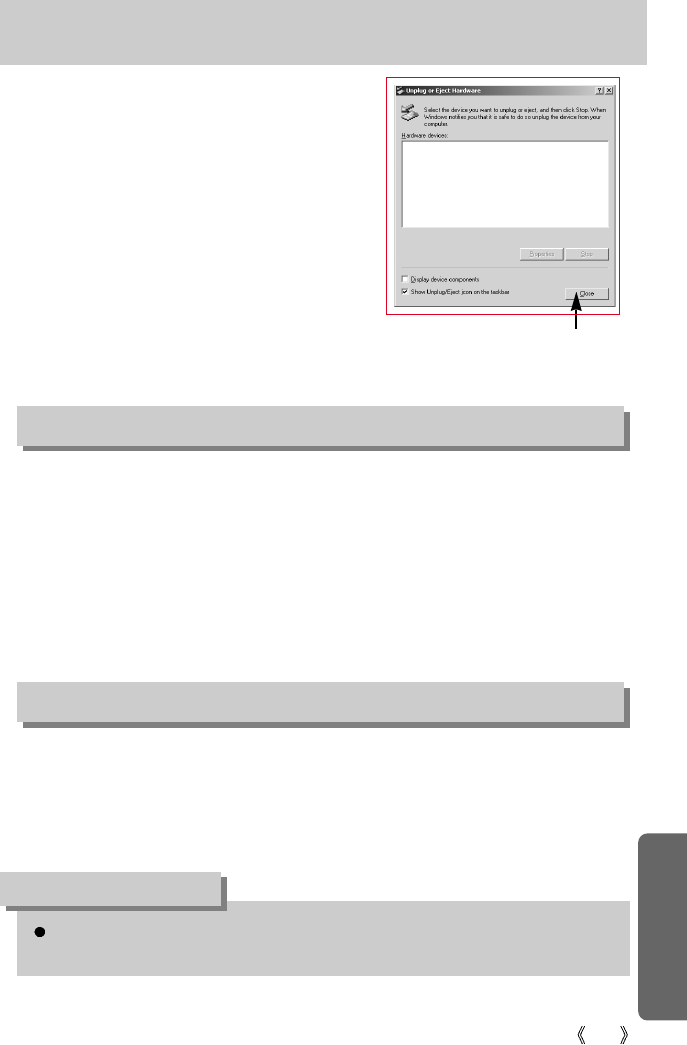
111
Removing the removable disk
1. A USB Driver for MAC is not included with the software CD as MAC OS supports the
camera driver.
2. Check the MAC OS. You can check the MAC OS version during MAC OS start-up. This
camera is compatible with MAC OS 9.0 ~ 10.2.
3. Connect the camera to the Macintosh and turn the camera power on.
4. A new icon will be displayed on the desktop after connecting the camera to the MAC.
Using the USB Driver for MAC
Setting up the USB Driver for MAC
1. Double click a new icon on the desktop and the folder in the memory will be displayed.
2. Select an image file and copy or move it to MAC.
For Mac OS 10.0 or later: First complete uploading from computer to camera and then
remove the removable disk with the Extract command
INFORMATION
6. A [Unplug or Eject Hardware] window will
open. Click the [Close] button and the
removable disk will be removed safely.
7. Unplug the USB cable.
[Click!]
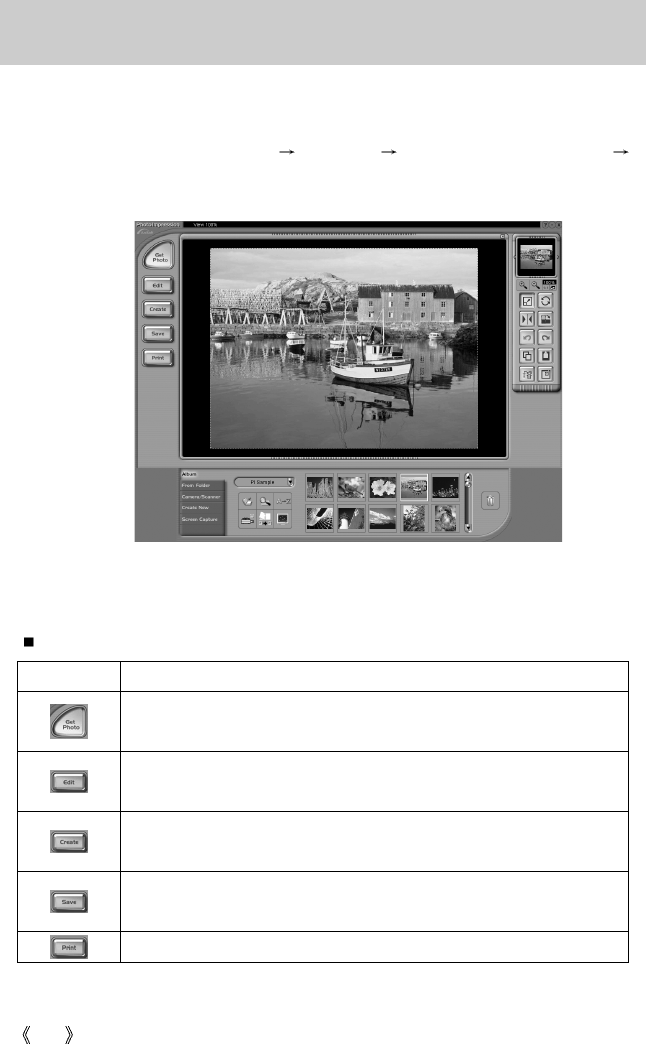
112
Using PhotoImpression
You can use PhotoImpression to perform the following tasks.
With PhotoImpression, you can edit or store still images that you downloaded from the camera.
This software is only available in Windows version.
To start the program, click [Start Programs ArcSoft PhotoImpression 4
PhotoImpression4]. The following screen will appear.
[ Command Button ]
[ Tool Bar ]
Command Button
Button Description
Imports a picture from an album, a source folder, or the camera/scanner, or
captures screen shots of what is being viewed on the current monitor.
Selects Cut, Resize, Edit Image, Insert Text, Enhance Picture, Insert
Effects, or Layer.
Performs Insert Frame, Insert Borders, Insert Calendar, Insert Greeting
Cards, Insert Template, or Connect with Other Software.
Saves the edited picture, and sends an e-mail or uses it as the background
image.
Outputs the edited picture according to your preferences.
[ Help Button ]
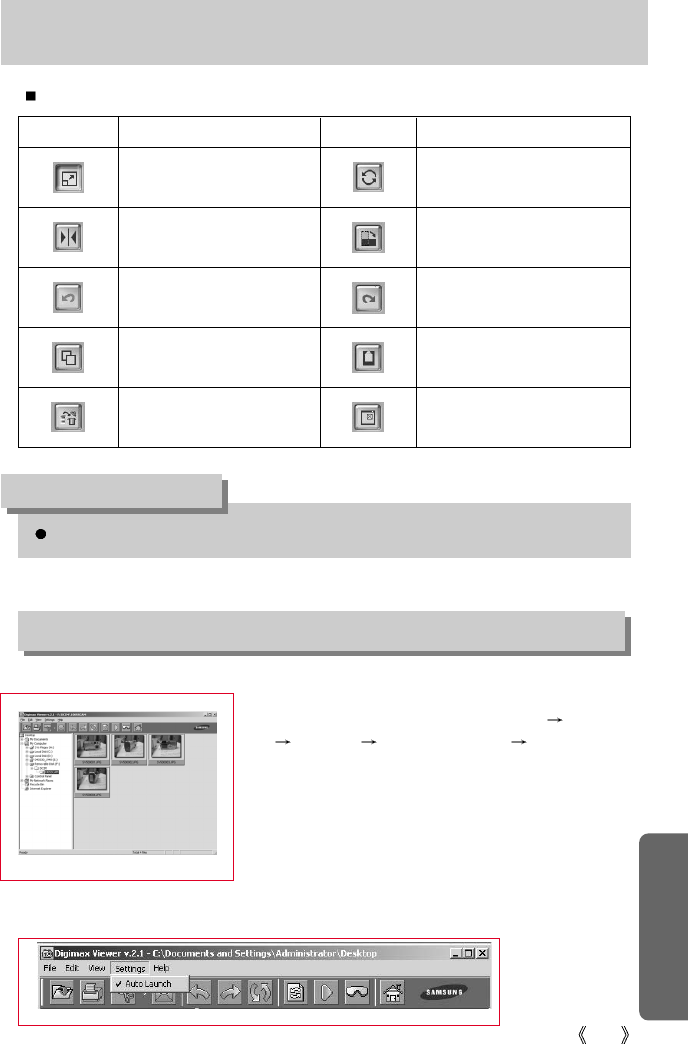
113
Using PhotoImpression
Tool Bar
Button Description Button Description
Resize Layer
Flip Layer Horizontally
Undo
Copy
Delete Layer
Rotate Layer
Rotate All Layers
Redo
Paste
Close Picture
For detailed instruction on how to use PhotoImpression, please refer to the program's Help.
INFORMATION
Digimax Viewer 2.1
This software is only compatible with Windows.
1. To open Digimax Viewer, click the [Start Programs
Samsung Digimax Viewer 2.1 Digimax Viewer
2.1 ] and Digimax Viewer 2.1 will then open.
2. If the [Auto Launch] option is selected, this program will be executed automatically with
recognizing the camera.
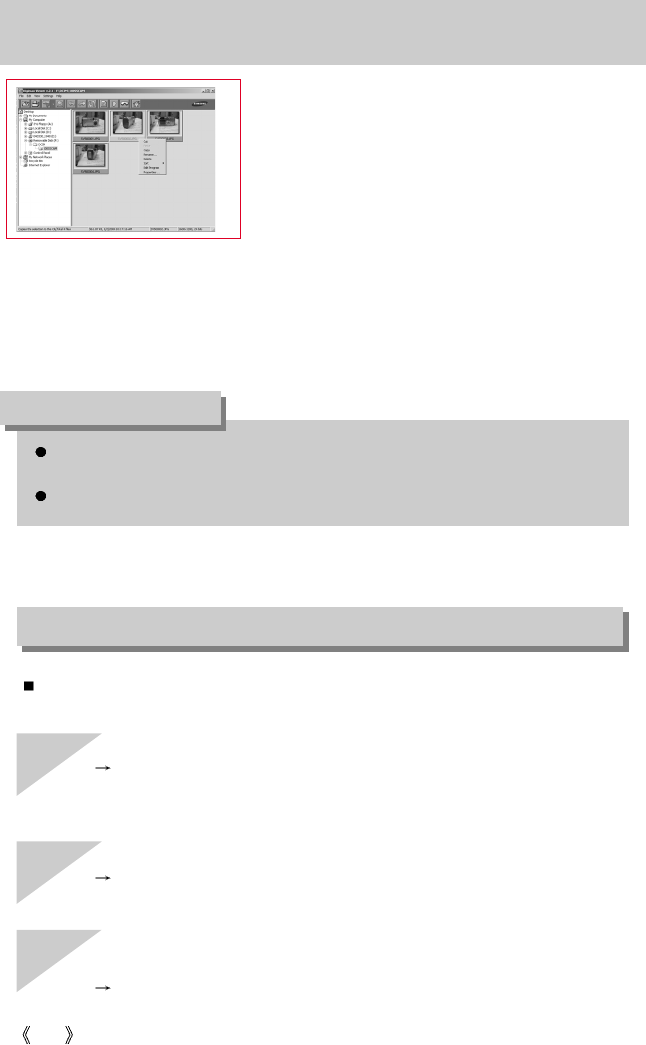
114
Digimax Viewer functions are listed below.
- Basic functions : Copy, Cut, Paste, Delete, Rotate, Rename, changing file type, Resize,
Property.
- Advanced functions : Print, Slide show, Export, Sending e-mail, On-line print, Web album etc.
Digimax Viewer 2.1
Please check the following if the USB connection malfunctions.
[Case 1] The camera power is off.
Turn the camera power on. We recommend using an AC power adapter in PC
mode.
[Case 2] USB Driver is not installed correctly.
Install the USB Driver correctly. Refer to page 99.
[Case 3] The USB cable is not connected or you are using a cable with an incorrect
specification.
Use a USB cable with the correct specification.
Before deleting images from the camera, you should protect or download images to your
computer that you wish to keep.
Refer to the [Help] menu in Digimax viewer 2.1 for further information.
INFORMATION
FAQ
3. You can easily use the Digimax viewer 2.1 program as
it offers a FILE menu and TOOL bar. And, you can use
the pop up menu. Click an image and press the right
mouse button.
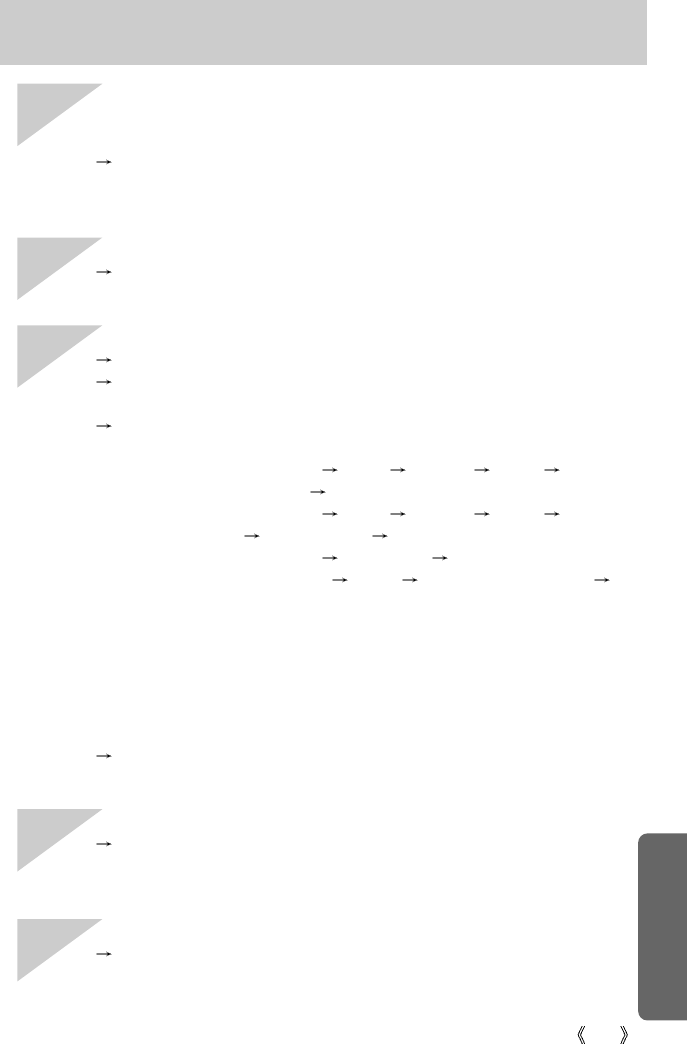
115
FAQ
[Case 4] The camera is not recognized by your PC.
Sometimes, the camera may appear under [Unknown Devices] in Device
Manager.
Install the camera driver correctly.
Turn off the camera, remove the USB cable, plug in the USB cable again, and
then turn on the camera.
[Case 5] There is an unexpected error during file transfer
Turn the camera power off and on again. Transfer the file again.
[Case 6] How do I know my computer supports a USB Interface?
Check the USB port in your computer or keyboard.
Check the OS version.
A USB Interface is available in Windows 98, 98SE, 2000, ME .XP.
Check [Universal serial bus controller] in Device Manager.
Do the following to check [Universal serial bus controller].
Win 98/ME : Trace [Start Setting Controller System Device
Manager Universal serial bus controller]
Win 2000 : Trace [Start Setting Controller System Hardware
Device Manager Universal serial bus controller].
Win XP : Trace [Start Control Panel Performance and
Maintenance System Hardware Device Manager
Universal Serial Bus controller].
There must be USB Host Controller and USB root hub under [Universal serial
bus controller].
In addition, double-click on the USB Universal Host Controller and the USB
Root Hub to check if the Device Status states "This device is working properly".
If the Device Status says the device is "not working properly", click the "Driver"
tab and then click [Update Driver] or [Reinstall Driver].
When all the conditions mentioned above are met, the computer can support
the USB interface.
[Case 7] When using the USB hub.
There may be a problem in connecting the camera to the PC through the USB
hub if the PC and the hub are not compatible.
Wherever possible, connect the camera to the PC directly.
[Case 8] Are other USB cables connected to the PC?
The camera may malfunction when it is connected to the PC at the same time
as another USB cable. In this case, disconnect the other USB cable, and
connect only one USB cable to the camera.
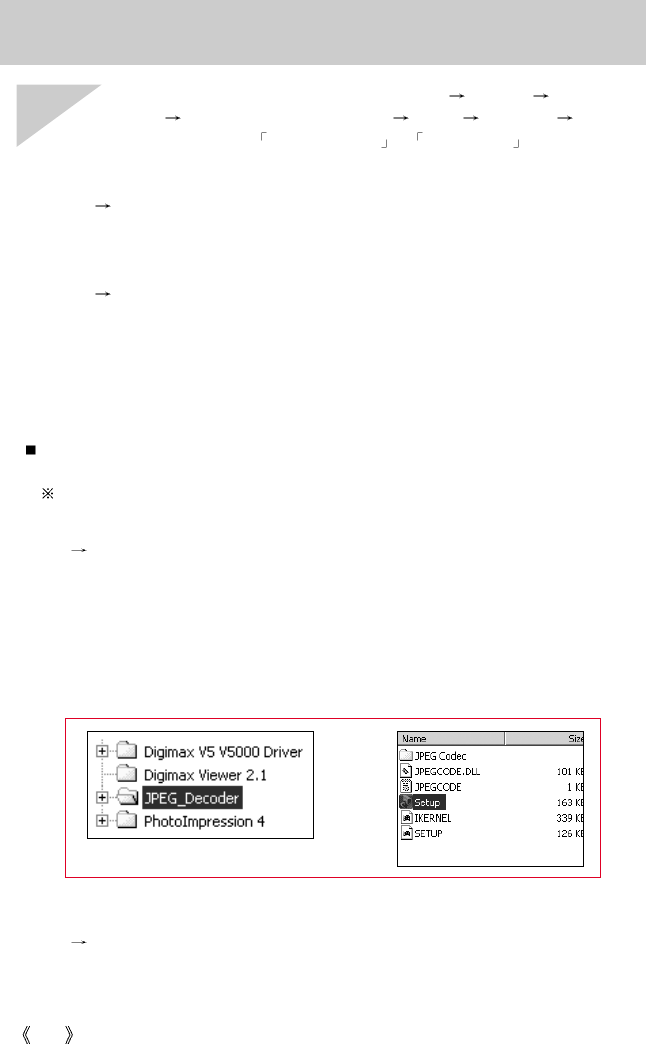
116
FAQ
[Case 9] When I open the Device Manager (by clicking Start (Settings) Control
Panel (Performance and Maintenance) System (Hardware) Device
Manager), there are Unknown Devices or Other Devices entries with a
yellow question mark(?) beside them or devices with an exclamation mark(!)
beside them.
Right-click on the entry with the question(?) or exclamation (!) mark and select
"Remove". Restart the PC and connect the camera the again.
For Windows 98 PC, remove the camera driver also, restart the PC, and then
reinstall the camera driver.
Double-click on the entry with the question (?) or exclamation (!) mark, click the
"Driver" tab, and click [Update Driver] or [Reinstall Driver]. If a message appears
asking you to specify the location of the appropriate device driver, specify "USB
Driver" in the CD supplied.
If you installed an incorrect codec onto your PC, the movie clip may not play back on the PC.
1. Check whether the JPEG Decoder provided with the camera is installed.
If you didn't install the camera driver, please install the JPEGCODE included in the
application S/W CD-ROM. If not, the movie clip may not play back on the PC.
[ Installing the JPEG Decoder ]
1) Insert the CD provided with the camera.
2) Run the windows explorer and select the CD-ROM drive.
3) Select the JPEG_Decoder folder and double click the Setup.exe file.
The codec will be installed.
Please check the following if the movie clip doesn't play back.
2. Compatible problems with the codecs installed onto the PC.
If the movie clip doesn't play back after installing the JPEG Decoder, refer to the
following.
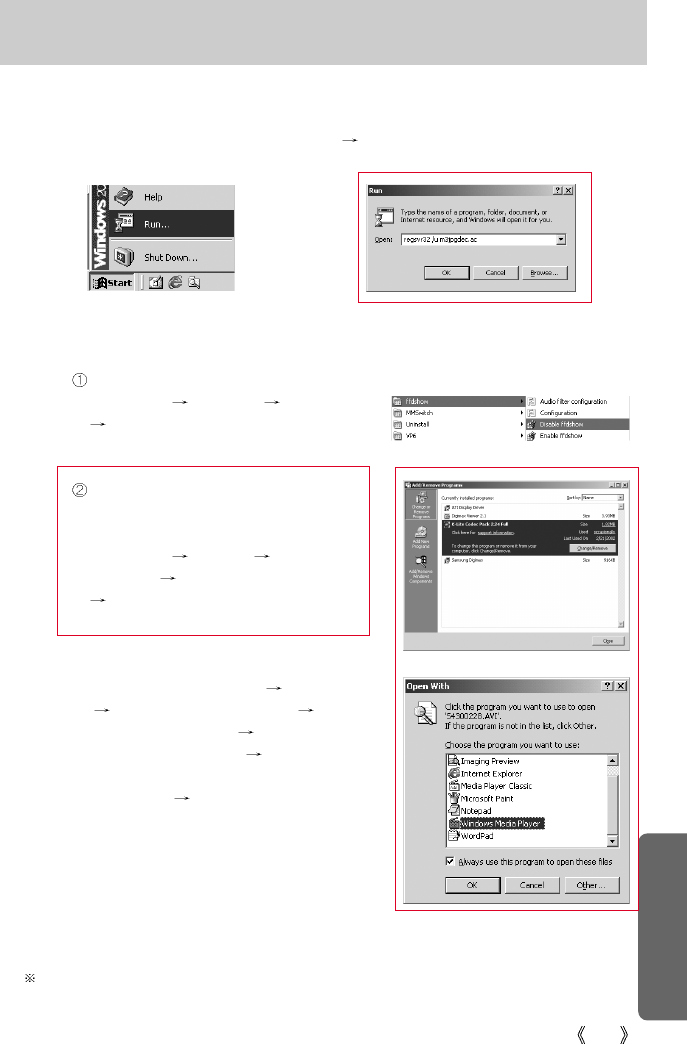
117
FAQ
1) When the movie clip plays back, only the sound plays back without the image.
It isn't compatible with the Mogen MJPEG Decoder. Uninstall the Mogen MJPEG
Decoder as following order. Click [Start Run] and a window will open.
Type "regsvr32 /u m3jpgdec.ax" and press the Enter key.
Most problems will be solved with those remedies. If the movie clip doesn't play back
continuously, install the JPEGCODE provided with the camera again.
For more information, visit the samsung website(www.samsungcamera.com) and see the
FAQ page.
2) When the movie clip plays back, the blue and red colors are reversed or the movie clip
doesn't open. It isn't compatible with the ffdshow Codec or K-lite Codec Pack.
Disable the ffdshow program.
Trace [Start Programs ffdshow
Disable ffdshow].
Uninstall the K-Lite Codec Pack or set the
default program of the AVI file as the
Windows Media Player.
Trace [Start Cotroller Add/ Remove
Programs Select the K-Lite Codec Pack
Click the Change/ Remove button].
Run the windows explorer Select AVI file
Click the right mouse button Select
the "Open with" menu Click the
Windows Media Player Check the
"Always use this program to open these
files" option Click the [OK] button.
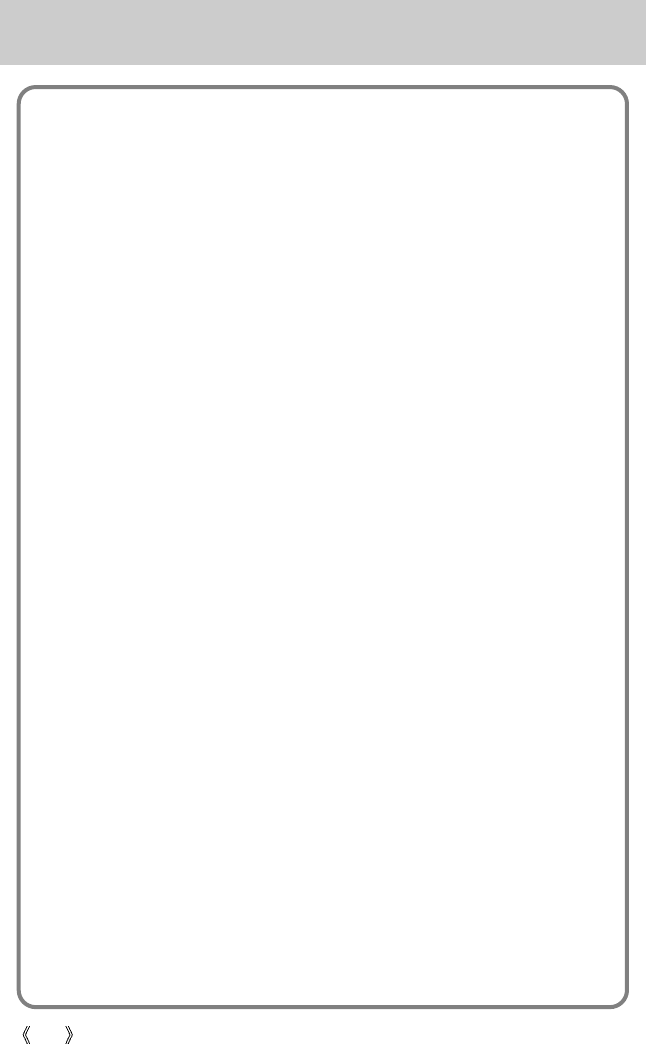
118
Information to the user
NOTE: This equipment has been tested and found to
comply with the limits for a Class B digital device,
pursuant to part 15 of the FCC Rules. These limits are
designed to provide reasonable protection against
harmful interference in a residential installation.
This equipment generates, uses and can radiate radio
frequency energy and, if not installed and used in
accordance with the instructions, may cause harmful
interference to radio communications. However, there is
no guarantee that interference will not occur in a
particular installation. If this equipment does cause
harmful interference to radio or television reception,
which can be determined by turning the equipment off
and on, the user is encouraged to try to correct the
interference by one or more of the following measures:
- Reorient or relocate the receiving antenna.
- Increase the separation between the equipment and
receiver.
- Connect the equipment into an outlet on a circuit
different from that to which the receiver
is connected.
- Consult the dealer or an experienced radio/TV
technician for help.
CAUTION : Changes or modifications not expressly
approved by the party responsible for compliance could
void the user’s authority to operate the equipment.
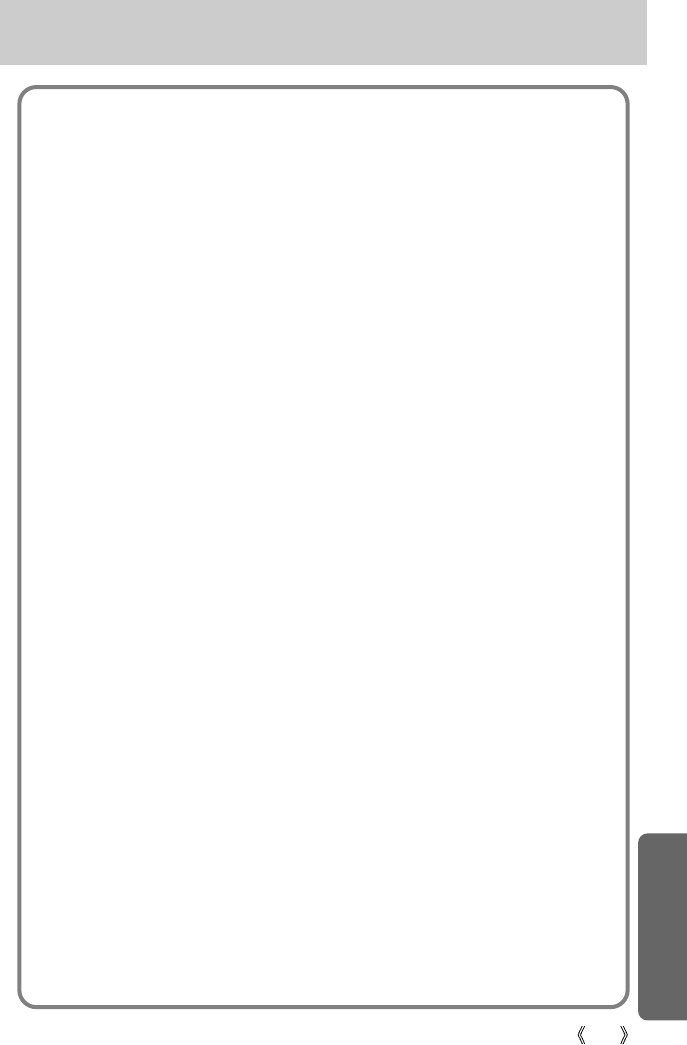
119
MEMO
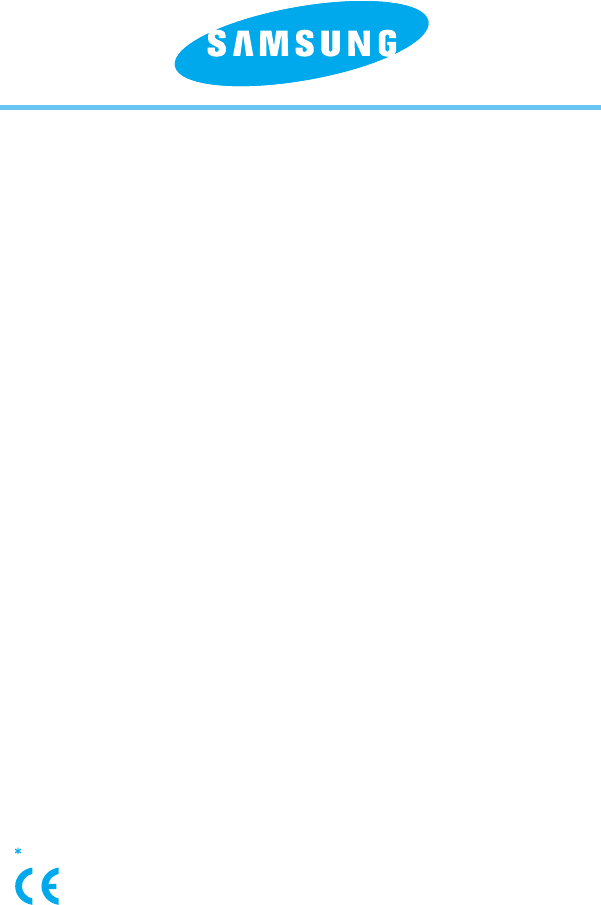
6806-1970
SAMSUNG TECHWIN CO., LTD.
OPTICS & DIGITAL IMAGING DIVISION
145-3, SANGDAEWON 1-DONG, JUNGWON-
GU,SUNGNAM-CITY, KYUNGKI-DO, KOREA
462-121
TEL : (82) 31-740-8086,8088, 8090, 8092, 8099
FAX : (82) 31-740-8398, 8111
SAMSUNG OPTO-ELECTRONICS AMERICA, INC.
HEADQUARTERS
40 SEAVIEW DRIVE, SECAUCUS, NJ07094, U.S.A.
TEL : (1) 201-902-0347
FAX : (1) 201-902-9342
WESTERN REGIONAL OFFICE
18600 BROADWICK ST.,
RANCHO DOMINGUEZ, CA 90220, U.S.A.
TEL : (1) 310-900-5263/5264
FAX : (1) 310-537-1566
SAMSUNG OPTO-ELECTRONICS UK LIMITED
SAMSUNG HOUSE
1000 HILLSWOOD DRIVE
HILLSWOOD BUSINESS PARK
CHERTSEY KT16 OPS U.K.
TEL : +44 (0) 1932 455300
FAX : +44 (0) 1932 455325
SAMSUNG OPTO-ELECTRONICS GMBH
AM KRONBERGER HANG 6
D-65824 SCHWALBACH/TS., GERMANY
TEL : (49) 6196 66 53 03
FAX : (49) 6196 66 53 66
SAMSUNG FRANCE S.A.S.
BP 51 TOUR MAINE MONTPARNASSE
33, AV .DU MAINE
75755, PARIS CEDEX 15, FRANCE
HOTLINE PHOTO NUMÉRIQUE :
00 800 22 26 37 27(Numéro Vert-Appel Gratuit)
TEL : (33) 1-4279-2282/5
FAX : (33) 1-4320-4510
SAMSUNG TECHWIN MOSCOW OFFICE
RUSSIA, 125167, MOSCOW LENNINGRADSKY,
PR-KT, 37-A, KORP14
TEL : (7) 095-258-9299/96/98
FAX : (7) 095-258-9297
http://www.samsungcamera.ru
TIANJIN SAMSUNG OPTO-ELECTRONICS CO.,LTD.
7 PINGCHANG ROAD NANKAI DIST., TIANJIN
P.R CHINA
POST CODE:300190
TEL : (86) 22-2761-8867
FAX : (86) 22-2761-8864
Internet address - http : //www.samsungcamera.com/
The CE Mark is a Directive conformity
mark of the European Community (EC)